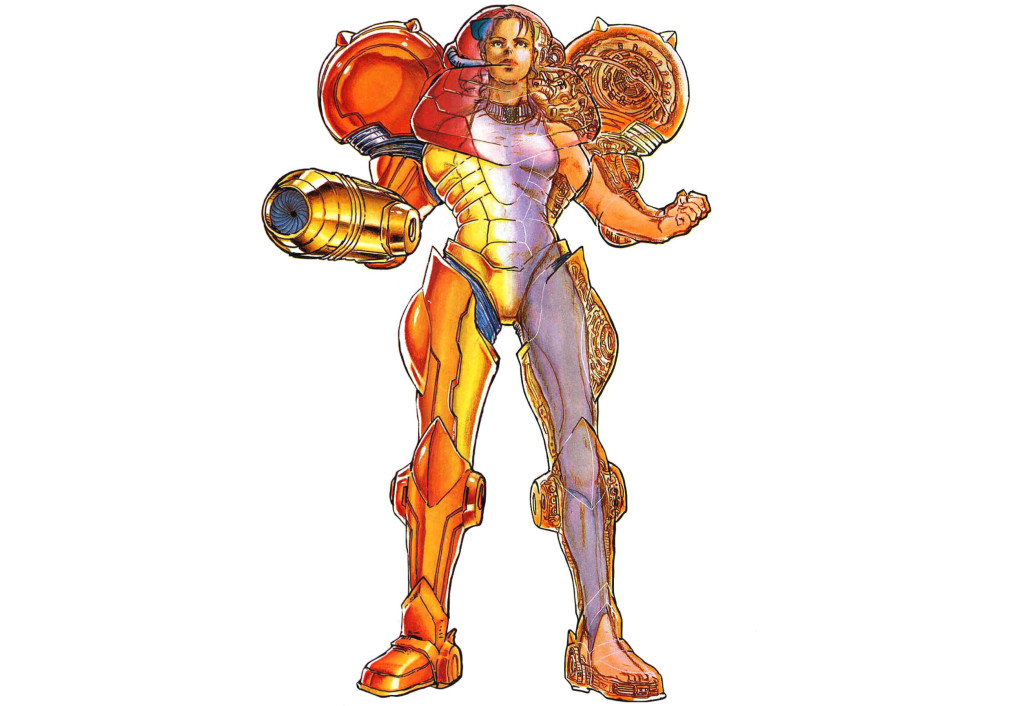
Samus Aran.
Badass bounty hunter. Galactic savior. Hero and protagonist of a videogame series that has endured for almost thirty years.
Samus Aran is among the most iconic videogame characters of all time. As far as female protagonists go, Samus is the earliest surviving one. Aside, I guess, from Ms. Pac-Man, but can you really count an anthropomorphized yellow blob? Samus is — at the very least — the oldest surviving female protagonist we can identify with. You know, since she’s human. Or at least humanoid. Back in 1986, even if you owned the original Metroid, even if you’d beaten it, you may not have known what was under the suit unless you finished the game especially fast and saw the secret endings.
It was a simpler time then. As we fought through the tunnels of Zebes and defeated the metroids, we were content to know just the most basic information: We were a bounty hunter named Samus Aran, saving the universe on a mission from the Galactic Federation. We were the hero. The good guy. And that was all we needed to know.
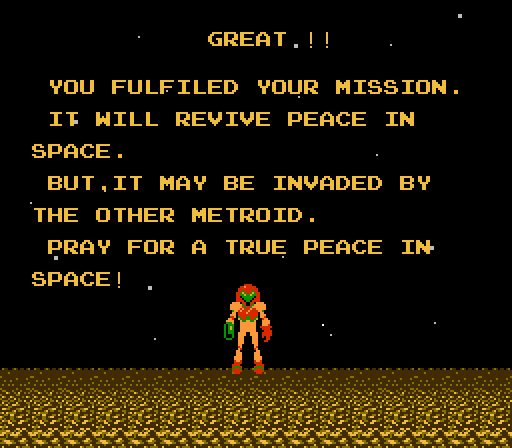
So the revelation, at the end of Metroid, that under the suit was a human being — and a woman, at that? I never got a chance to experience the raw surprise for myself, but from all accounts, it was quite a shock. Male players may have felt a bit bewildered, but for female players, this was one of the first times they had ever seen a player character — pixelated and scanlined and hidden in a secret ending though she might have been — who looked like them.
And think: this wasn’t some “for girls” game where the object was to bake cakes or color-coordinate outfits, or an arcade-y thing where you had to escape from monsters. No, Samus Aran was a hero on an adventure. Her gender didn’t really matter in the scope of the game. Samus — before and after we knew she was female — controlled the same as any other player avatar. She ran, she jumped, she fought. She defeated the bad guys and saved the day.
She did everything a man could do.
Nothing Lasts Forever
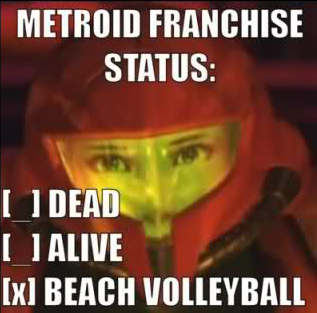 Twenty-five years later and things aren’t so simple. Samus has been going through some rough times lately. The bile has subsided somewhat, but you can still see the scars of the great tumult all over the internet: webcomics, image macros, YouTube videos. 2010’s Metroid: Other M was the most recent entry in the series, and to say that it was controversial doesn’t nearly cut it. Other M was immediately condemned upon release by a large and very vocal contingent of fans, not to mention critics.
Twenty-five years later and things aren’t so simple. Samus has been going through some rough times lately. The bile has subsided somewhat, but you can still see the scars of the great tumult all over the internet: webcomics, image macros, YouTube videos. 2010’s Metroid: Other M was the most recent entry in the series, and to say that it was controversial doesn’t nearly cut it. Other M was immediately condemned upon release by a large and very vocal contingent of fans, not to mention critics.
While much of the criticism was focused on things like gameplay or presentation or writing, the strongest outrage was over the way Samus was portrayed. Other M was the first game in the series to put an emphasis on story, the first to incorporate extensive cutscenes (nearly two hours worth), and the first to delve into who Samus was as a person. It was long-time Metroid director Yoshio Sakamoto’s intention from the beginning that this be the Metroid game that finally presented, in his words, “an intriguing depiction of Samus’s humanity.”
As it turned out, this “intriguing depiction” of Samus ran contrary to the impression most fans had of their hero up to this point. In all other instances, she had always seemed to keep her emotions in check, always seemed to be strong and self-sufficient. She had proven herself a woman who was in control — both of herself and of the bizarre and precarious events that surrounded her. Other M, in contrast, showed her cowed into submission by a male authority figure who was, if not outright abusive, at least cruel and incompetent. It depicted a Samus who wouldn’t challenge foolish orders, wouldn’t stand up for herself when she was insulted or put in danger. And it tried to tell us that the Samus we had long known to be an ass-kicking bounty hunter was in fact a slave to her emotions.
I don’t think it’s a stretch to say that this Samus wasn’t the Samus who fans had grown to admire. She wasn’t the one-woman army feared across the galaxy. She wasn’t the icon of the videogame history books: a female hero in a medium dominated by men, who bucked every stereotype about women — and who proved herself just as capable and cool as any of her counterparts. The new Samus wasn’t a hero who young female gamers could look up to, and she wasn’t someone who, when those players grew up, they could be proud to say represented their gender on the TV screen.
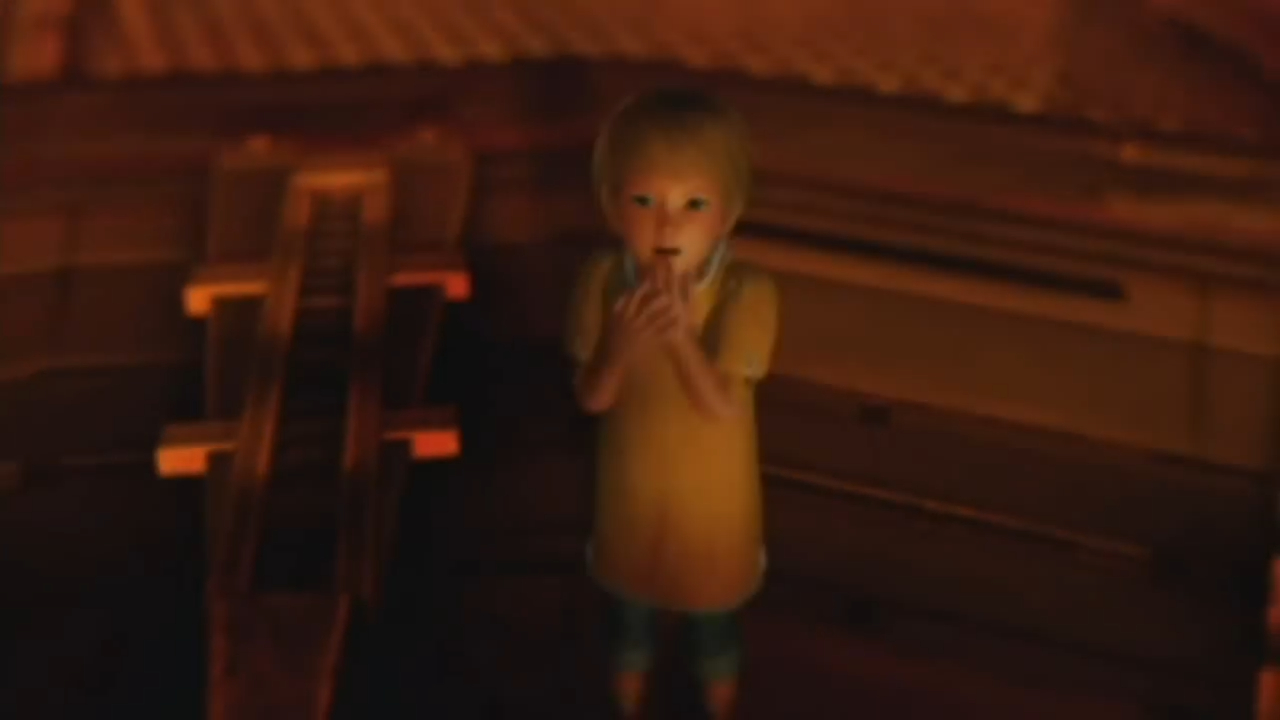
Still, it’s been five years since Other M came out, and almost as long since the the outrage died down. Five years is an eternity in videogame time. Why talk about it now?
Well, because the treatment of Samus Aran is important, and not just for the Metroid series or for Nintendo. What happened to Samus is important for videogames as a medium, for the developers of those games, and it’s important for us, the players. Both the developers and players have too often neglected to look back, to recognize the mistakes that were made, and to learn from them. I hope this can go down in history as the time we finally got it right. If no one learns from the mistakes of Other M, the futures of both Samus and female videogame characters in general don’t look very promising.
Maybe the time that’s passed is a blessing. Both Other M‘s critics and its supporters were very quick to shout the other side down, and starting a conversation in that sort of environment isn’t easy. Maybe now that we’ve had some time to simmer down and let the wounds heal, we can have the conversation that we weren’t able to have back then. It’s a conversation that we need to have sooner rather than later.
The ‘S’ Word
There’s one word that came up almost immediately in discussions of Other M after release, and in gaming circles this word is often an instant game over for civil discourse. Unfortunately, I can’t skirt around it for long because it’s so central to everything that’s wrong with Other M. Instead of even trying, I’m going to get it out in the open from the start: what we’re talking about here is sexism.
Some of the most articulate and comprehensive writings on Other M leave the topic of sexism until after they’ve convinced readers of some of their easier-to-swallow criticism. MenTaLguY and Tuvia Dulin’s brilliant deconstruction relegates the most direct confrontation with sexism to a relatively short passage toward the end. Over on TVTropes, let’s player Korval doesn’t come to the conclusion that Other M is sexist until the last two sections of his novel-length play-by-play.
Unfortunately, I don’t have that luxury; what I want to look at is sexism — and how it’s taken hold of the Metroid series over the last three decades.
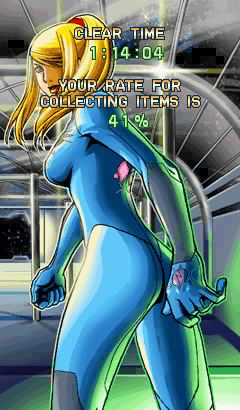
A large and vocal contingent of Metroid fans will tell you that Other M ruined the otherwise flawless Metroid franchise. If the problem with Other M is sexism, then the assumption here is that sexism hasn’t existed in any of the other games. But google “metroid sexism” and you’ll find plenty of critics calling out not just the most recent game, but all of Metroid‘s history as troublingly sexist, primarily because of the way Samus herself has acted as a reward for skillful play in almost every game.
It’s more than that, though. That’s not the only sexist element in the series, nor was sexism a brand new thing introduced to the series with Other M. 2010 only marked the culmination of trends that have been building steadily over the course of the series. Other M was only the last in a long line of games that have weakened and sexualized the character of Samus Aran. My intent here is to trace the course of that decline — from its humble, innocent beginnings in the original Metroid to its offensive, irresponsible conclusion in Other M.
Without the Power Suit
It’s no secret that Samus’ body has been sexualized day one. And maybe I’m an apologist, but I can see how it began innocently enough. Metroid‘s developers in Nintendo R&D1, at some late stage in the development of the first game, made a decision that would change everything. They had designed the game up to this point with the intention of the hero simply being a genderless android. But what if it was only a suit — and underneath the metal exoskeleton, the hero was a woman?
It would have massive implications for the series, and for videogames, but in the scope of this one game, it had almost none. Nothing would change, except that at the end, you’d get to see who was under the suit the whole time. The devs, I imagine, just thought of it as a cool, surprising reveal, and if that was the case, what if it was even more exclusive than just beating the game? What if you only got the reveal if you proved you were really good at it? Every kid who got saw the “twist” ending would tell his or her friends about it. It would be an awesome badge of honor and it would spread word of the game at the same time.
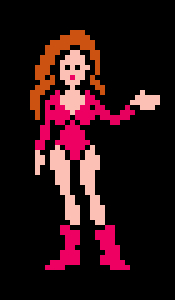 So R&D1 drew up a few sprites that would only appear if the player completed the game in a certain amount of time. To make sure you could tell it was a woman despite the low resolution and limited palette, they threw in all the gender signifiers they could manage. If you did it in five hours, Samus would take off her helmet and reveal a face with cherry-red lips and big ’80s hair. But maybe that wasn’t enough, so for under three hours you’d see Samus’ whole body — hourglass-shaped, with exaggerated breasts and a pink leotard.
So R&D1 drew up a few sprites that would only appear if the player completed the game in a certain amount of time. To make sure you could tell it was a woman despite the low resolution and limited palette, they threw in all the gender signifiers they could manage. If you did it in five hours, Samus would take off her helmet and reveal a face with cherry-red lips and big ’80s hair. But maybe that wasn’t enough, so for under three hours you’d see Samus’ whole body — hourglass-shaped, with exaggerated breasts and a pink leotard.
Already there’s an uncomfortable sense of rewarding greater accomplishment with more of Samus’ body. Do good — here’s some skin. It wasn’t ideal, or politically correct, but I feel like I understand how this happened and why Samus came out looking the way she did — and I think it would have been forgivable if not for the last sprite. This time it was for completion in under one hour, and this time Samus was in a bikini. Sure, it was probably 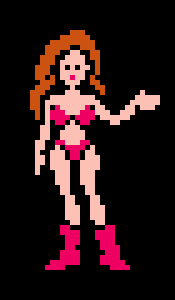 just the artist getting a chance to enjoy himself by drawing a sexy girl instead of weird space monsters for once. And sure, male players liked it. No one was hurt, right?
just the artist getting a chance to enjoy himself by drawing a sexy girl instead of weird space monsters for once. And sure, male players liked it. No one was hurt, right?
Not directly, no. But think about the message being sent: even from the very first Metroid game, Samus’ body was a reward. She was commodified — a thing you were treated to as trophy.
Let’s look at this from a different angle. What if Samus had been male? Would it have even crossed anyone’s mind to put him in, say, swim trunks? Or his underwear? No, never. But because Samus was female, it was the obvious choice.
You can easily trace this trend through the rest of the series, too. Complete Metroid II: The Return of Samus and Super Metroid in three hours or less? Here’s your complimentary Samus in either her underwear or a weird ‘90s workout suit (in Return and Super respectively).
 If we follow the main-line, 2D series from Super Metroid into Metroid Fusion, we’ll see it continue on. Here, Samus sports a similarly revealing outfit, but now we’re treated to three different images of her, flipping her hair sassily or gazing upward with her eyes closed. Looking sexy and submissive.
If we follow the main-line, 2D series from Super Metroid into Metroid Fusion, we’ll see it continue on. Here, Samus sports a similarly revealing outfit, but now we’re treated to three different images of her, flipping her hair sassily or gazing upward with her eyes closed. Looking sexy and submissive.
But this is all well before the introduction of the infamous, skin-tight Zero Suit. Samus’ iconic suit-under-the-suit was first introduced in Metroid: Zero Mission, the remake of the original game. It supposedly allows Samus to interface more effectively with her Power Suit, but let’s be honest here: we all know the purpose of the Zero Suit, and it has nothing to do with making Samus’ life easier. It’s for the player’s benefit; it exists to show off Samus’ body as much as possible while maintaining Nintendo’s “family friendly” reputation.
When high heels were added to the Zero Suit in Other M, it shouldn’t have surprised anyone. For decades the series had been looking for any excuse to accentuate Samus’ body, so why wouldn’t they slap some high heels on that suit? Nevermind the practicality of it. Is it practical to wear your underwear under the power suit? I imagine there’d be a lot of chafing. Is it easy to move and bend and stretch in a skin-tight jumpsuit? Probably not. So the brilliant tactical tradeoff of Samus being awkward and unsteady on her feet in favor of making her ass look great?
No, I wasn’t surprised at all.
Impossible Standards
It’s hard to tell, admittedly, exactly what is going on in the smaller details of Samus’ early sprites. Her hair is a little long and impractical, and I imagine there’d be concern that it would fall in her eyes and get her killed. So there’s that. And we can pretty safely assume she’s wearing lipstick, going by the color of her lips, though I’m not sure why you’d wear lipstick under a helmet that obscures your mouth. But okay. Gender signifiers — I get it. We’ve got a female protagonist in a videogame; maybe it’s too soon to ask for her not to be overly feminized.
What boggles my mind is that rather than seeing a less sexualized portrayal of Samus over time, as feminism and progressive ideas become more mainstream, the exact opposite happens. The focus on her body is the more obvious aspect of Samus’ sexualization, but there’s also her increasingly heavy makeup and stylized hairstyle to consider. By Zero Mission, Samus has adopted not only eyeliner and heavier lipstick, but her now-famous hairstyle — the long ponytail, the big red hair tie, and the infinitely complicated bangs-spiral that’s held in place with some sort of space magic. “Wow!” you’re supposed to say, “she sure is pretty!” You know, because Samus is a girl and girls are always pretty all the time.

Let’s set aside the fact that this is one of the silliest hair styles since the original Star Trek. Maybe this is what’s fashionable in “20X5 of the history of the cosmos.” That doesn’t make it any more reasonable for Samus to wear her hair like this during a mission. Does she get a call from the Galactic Federation and then just put them on hold for two hours while she does her hair and makeup? Why wouldn’t she wear it in some more practical way so it’s not flopping around in front of her visor? Who is it supposed to impress, anyway?
I can tell you it’s certainly not for the Space Pirates. It’s for us, the players.
The more important question is: how does all this styling and makeup not go to waste? After running around for hours in a metal suit, fighting off a hundred alien monsters and surviving superheated volcanic environments, Samus doesn’t sweat a single drop? Really? Her makeup doesn’t run? Her hair doesn’t fall out of place?
In reality, we’re not supposed to think about any of this. We’re not supposed to question the amount of time or hair spray it takes for her to get ready. We’re certainly not supposed to question how she looks just as perfect at the end of a mission as she did at the beginning. Girls simply don’t sweat, their makeup never runs, and their hair never does anything they don’t want it to. They’re expected to always, effortlessly look pretty.
Male heroes often spend their time sweaty, dirty, and bloody. Look at the the Arkham games, where Batman gets steadily more beat up and bloody, his suit gets ripped, and his cape torn to shreds. Nintendo, on the other hand, refuses to ever make Samus Aran look anything but perfect. She’s expected to keep up her looks at all times. After all, that’s why we value girls.
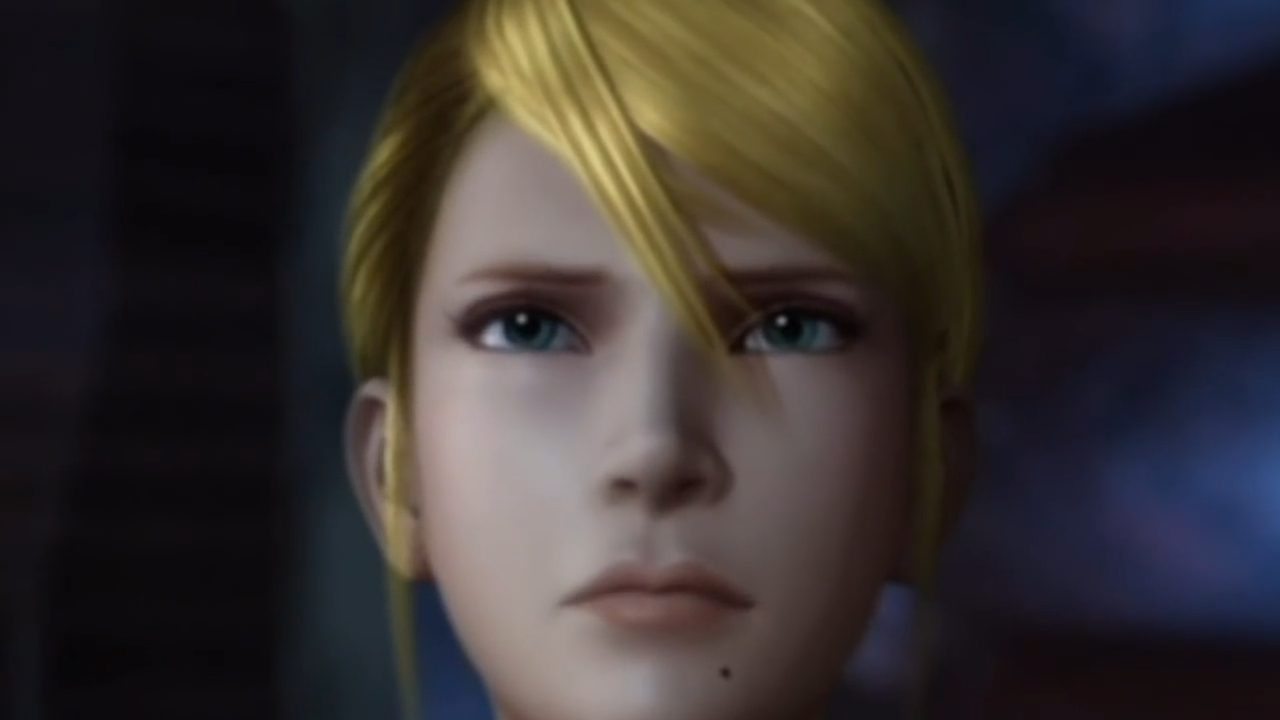
This is not okay. Beyond being a shallow appeal to male gamers and subtly feeding them unreasonable expectations of women, it gives female players an image of beauty that’s impossible to reach. Samus Aran has become the Barbie of videogames. She’s even been molded to more closely resemble a Barbie doll. In earlier games and guides, Samus is supposedly 6’3” and almost 200 pounds. She’s tall and muscular: a physically imposing warrior. Now look at Other M. Somehow, Samus has lost at least a foot of her height and all her muscle. Now she’d fit right in with Barbie’s friends: skinny arms, impossibly thin waist, huge child-bearing hips, and enormous breasts.
Over two or three decades, Samus has been changed to fit an ideal. She’s gone from commanding and tough to delicate and unthreatening. Why? Because that’s what men like. It may not make sense for the character to look this way, but they’ve got to appeal to an audience here, damn it!
Fanservice Overload
Samus’ perfect hair and makeup, and her shapely body, are obviously all to serve the moments when she’s is out of her Power Suit. I suppose it was less important back in the days when her appearances were locked away in secret ending screens – less important that Samus look her “best.” But as the series went on, she was out of the suit more and more. Super Metroid, Fusion, and Zero Mission, in addition to offering a scantily-clad Samus as the “reward” at the end of the game, also provide a glimpse of Samus’ body when you lose. Whenever she’s defeated, Samus’ suit literally explodes off of her body as she floats in midair and white light surrounds her. Hilariously, the developers had considered making her naked for these sequences, but decided it would be too titillating and would probably be censored.

With this new feature in Super Metroid, the sexualization of Samus had escaped just that final screen at the end. You could say the exploding suit is there to remind you who you’re playing as, I suppose. “Oh, that’s right. Samus is a girl.” But why does it need to be this sexual? The revealing clothing? The arched back? The uncomfortable implications — that when defeated, the Samus is rendered defenseless and naked before her enemies?
Zero Mission takes that defenselessness a step further. If you’ve played it, you’ll remember the sequence that was tacked on toward the end (but hadn’t been present in the original Metroid) where Samus is stripped of her suit after her ship crashes. Why does she lose her suit? There’s no justification ingame; it’s apparently just time for her to be without her suit.
Now, it’s true that Samus does head toward danger here, toward the Space Pirate vessel — demonstrating, to some extent, her resolve and courage. And that’s great, but it’s also true that this was her only option. The Space Pirate ship is sitting right on top of the Chozo temple where she can get a new power suit. The only other thing she could have done was sit helplessly in her damaged ship and hope for someone to rescue her.
The loss of the suit, though, results in a Samus who is suddenly weak and vulnerable. She must infiltrate a Space Pirate ship but can’t kill the enemies she encounters there. The pistol she carries only allows her to stun them long enough to run away and hide. And she must do this until she can find a new suit and regain her strength. Think about how this section of the story would play out in most other games. Were Samus a male protagonist who lost his weapons or whatever made him powerful, he would beat his enemies into a pulp with his bare hands. He would improvise weapons from the environment or lead the Pirates into a trap.
He would use his brain. And he’d still win.
Here, you aren’t even given a chance to confront the Space Pirates in any way. Just run and hide. Without the suit — the suit that hides her face and body and makes her nearly genderless — Samus is a defenseless, powerless woman. Also, can we just reflect for a moment on the fact that this moment of vulnerability is the perfect time for a fanservice-y shot of Samus’ ass? Great.
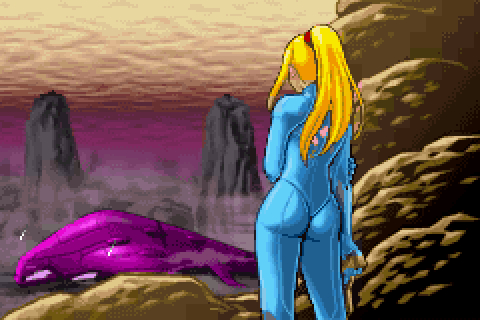
When Other M took the reins of the series in 2010, it cranked both Samus’ time out of the suit, and the corresponding powerlessness, up to eleven. It’s still a relatively short time compared to how much is spent in the suit, but nearly every second of it is used to show her to be both helpless and sexualized. In the opening, she begins by waking up on a bed in an medbay after being at the mercy of doctors and scientists. Leaving the medbay, she struts like she’s on a runway. And then the camera pans in to get a nice shot of her ass. In a later cutscene, she’s inexplicably stripped of her suit for the sole purpose of giving someone else a crowning moment of awesome. After he shoots her in the back and she briefly passes out, it’s Adam Malkovich who gets to make the heroic sacrifice while Samus stumbles around, out of breath and unable to do anything but watch someone else advance the plot. And then there’s the gameplay sequence in the secret ending where she has to escape the Bottle Ship without her suit on — which, just like the above part in Zero Mission, forces her to run from her enemies rather than fighting them.
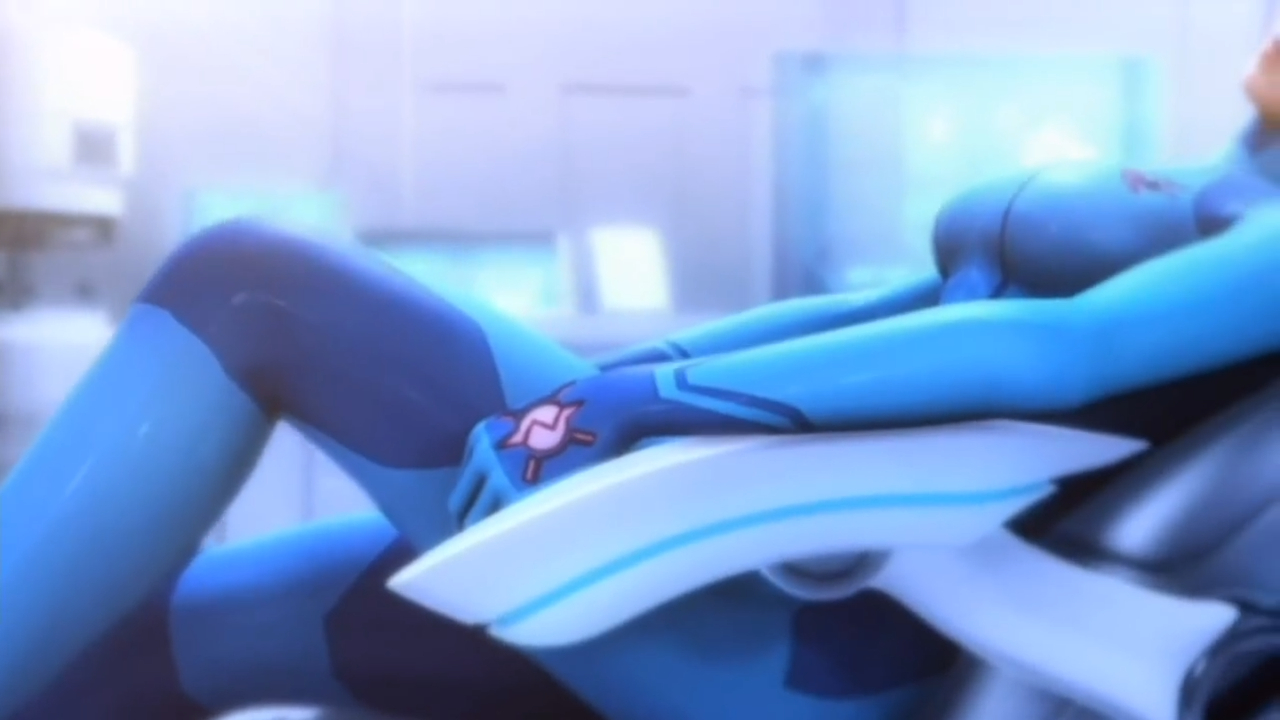
These instances of a suitless Samus Aran have increased over time, but they’ve always been for one of only two purposes: for obvious fanservice, or to explicitly show her weakness. Effectively, when Samus’ femininity is out in the open, that femininity is synonymous with delicacy and blatant sex appeal.
Samus Aran, Gender-Bender
In contrast, when Samus is inside her Power Suit, it’s impossible to tell what gender she is. Most people new to the series — most gamers especially — would see a tough, armored bounty hunter and assume that that bounty hunter is male. The look of the power suit makes that assumption even easier, obscuring any and all signifiers that could point to one gender or another. And the Fusion Suit later in the series even makes Samus look distinctly male, with its narrow hips and monstrously broad shoulders. So any time Samus is in one of her suits, her gender is effectively a mystery.
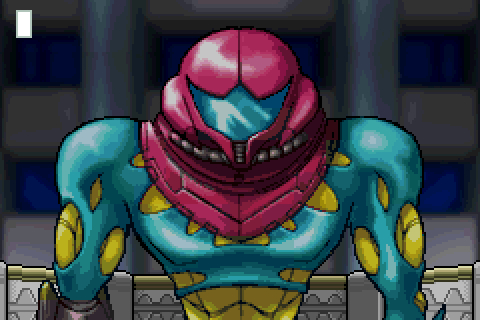
In a sense, suited Samus — bounty hunter Samus; galactic savior Samus — is a male (or at least genderless) persona that Samus can put on and take off. She dons her masculine form and goes off to save the galaxy. Samus, with the help of the suit, is dangerous and powerful.
Samus without the suit — Samus Aran, woman — has been made to be utterly at odds with this other persona. In its earliest incarnations, this Samus passively waved and looked pretty for the camera, and that was one thing. But through Zero Mission and Other M, we have come to know suitless Samus as someone who is incapable of defending herself without her Power Suit, and incapable of affecting the world around her until she gets it back.
How can these two Samuses be so at odds? Easy; the real Samus is not the hero. It’s the Power Suit that’s the hero of modern Metroid. It’s this masculine form that allows Samus to be heroic. In the suit, Samus can do great things. Out of it, she’s helpless. When her gender is hidden, she is powerful and in control. When the player can see that she is female, she is ineffectual at best. A woman can’t be a hero on her own merits alone.
Don’t Forget to Stay Dressed
If this wasn’t bad enough, around the time of Zero Mission, the Power Suit took on a new quality. What had once been implied to be a suit of metal and circuitry was retconned into something called “hard light.” The suit was still a physical object — light turned matter — but the new concept meant that it could be willed in and out of existence.
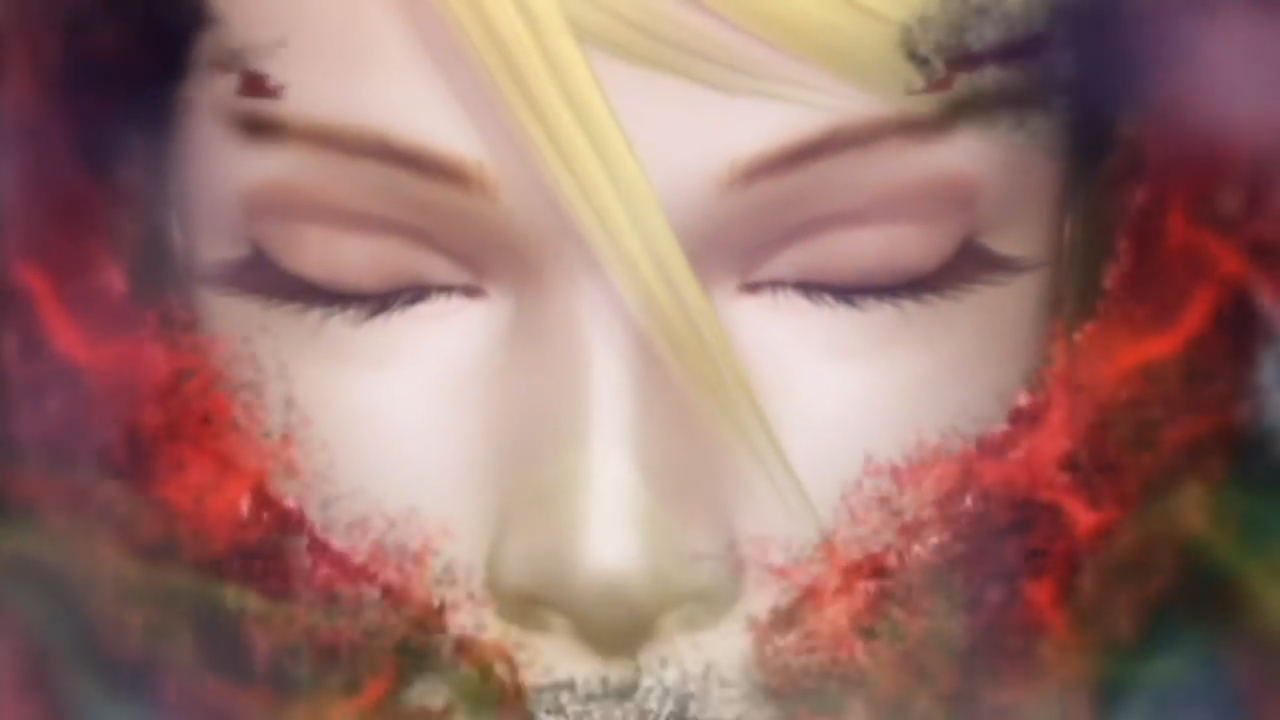
The concept alone is ridiculous. How did the Chozo give it to her? How do you give someone a thing that’s made of light? And where does it go when she wills it off? Is it stored somewhere? When she makes the suit materialize, how does it materialize under her feet? Does it levitate her an inch off the ground and then materialize?
But that’s not the point. The hard light suit is a stupid concept, but it’s not necessarily a problem we need to discuss here. What matters is that it was also written to be tied to Samus’ willpower. Rather than simply willing it to appear or disappear, it required a great deal of mental effort just to maintain.
You might ask why, and that would be a completely valid question. Why in the heck would the Chozo give her a suit of armor that requires focus just to keep it on? — focus that could be better used on the mission? Let me get this straight: instead of gearing their adopted daughter up in a normal protective suit, they put her in one that distracts her from whatever she’s doing, and could vanish at any moment?
Take a moment to digest that. Galactic savior Samus Aran, in the midst of battling some of the fiercest abominations from beyond the stars, has to concentrate on making her clothes not fall off. I don’t know where to begin. It doesn’t make sense in any context, in any universe, for any hero — male or female. But given that a concept this stupid does exist, does it really shock you that it’s the sexy girl hero who gets stuck with such a curse?
It may have seemed like a cool, futuristic concept. “Hard light!” The truth, though, is that it’s just an excuse for the writers to get Samus out of the suit more easily — to show off her hot, latex-clad body. No more heavy, metal contraption in the way. No need to write a long pause in the action so that Samus can carefully take the suit apart and remove it. Now it’s something that can be snapped out of existence with a flash of light, and it can be done any time the developers want to draw attention to Samus’ femininity.
We need to call a spade a spade; the hard light suit is easy access.
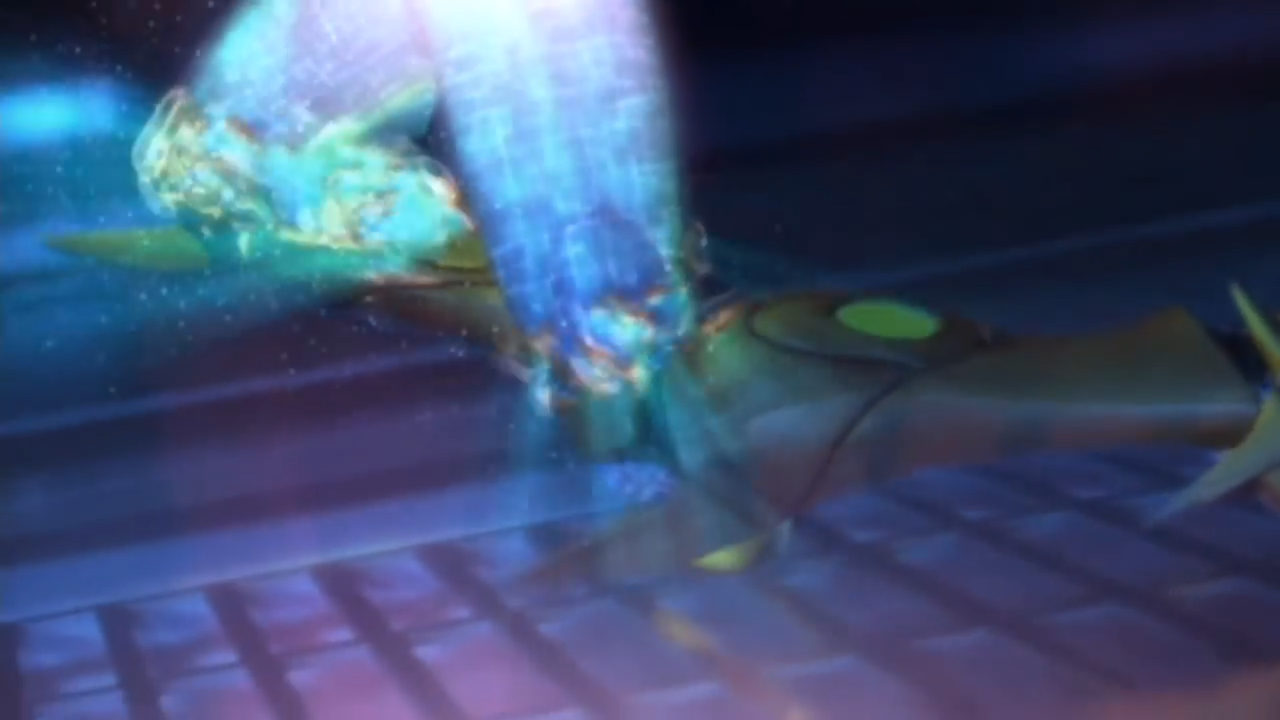
Other M goes even further, suggesting that the suit is prone to failing if Samus gets too emotional. In other words, her emotion is her weakness. A line was crossed here, whether Nintendo or Sakamoto or whoever rewrote the backstory on the Power Suit understood what they were doing when they crossed it.
See, men are allowed to show emotion in stories. Usually anger or jealousy or hatred, but emotion nonetheless. In fiction — and especially in videogames — those emotions often give them strength. Got a hero whose girlfriend was killed by the big bad? I guarantee you that the lust for revenge is what fuels the plot and sees him through to the end.
Society expects different emotions from women: love, caring, sentimentality. But those emotions are also seen as weak. Since Samus is a woman, she’s not allowed to feel things like anger, or to want revenge. She wouldn’t fit our ideal of femininity if she did. Instead, games like Other M force onto her those “weak” emotions, caring and maternalistic feelings, and it’s those emotions that are the chink in her armor — literally. She’s required to keep them in check — otherwise her femininity is revealed, her strength evaporates, and she’s left defenseless, powerless, and… as a sort of sick bonus, she’s also left in a sexy latex jumpsuit for us to ogle at.
Mother of Mercy
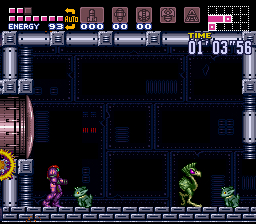 In part, the emotionality of the new Samus is a reaction to her perceived lack of any personality in previous games. There’s some truth to the claim that Samus didn’t have much character prior to Other M, but she had some. She was courageous, without a doubt. The trademark thumbs-up (prior to Other M completely subverting its meaning) also spoke to some degree of cockiness. And her actions spoke of a character who felt compassion toward others, human and alien alike. The friendly dachora and etecoons she rescues on Zebes in Super Metroid? — she puts her own safety at risk to do it, even while she’s trying to escape the planet’s utter destruction.
In part, the emotionality of the new Samus is a reaction to her perceived lack of any personality in previous games. There’s some truth to the claim that Samus didn’t have much character prior to Other M, but she had some. She was courageous, without a doubt. The trademark thumbs-up (prior to Other M completely subverting its meaning) also spoke to some degree of cockiness. And her actions spoke of a character who felt compassion toward others, human and alien alike. The friendly dachora and etecoons she rescues on Zebes in Super Metroid? — she puts her own safety at risk to do it, even while she’s trying to escape the planet’s utter destruction.
Expanding upon that established characterization would have been perfectly acceptable, and not one fan would have complained. Why, when given the opportunity to develop Samus as a character, did we instead get a buffet of sexist, stereotypically feminine traits? Why not further develop her courageous spirit? Her seemingly head-strong mentality? Her desire to help others even at the cost of her own life? Or, why not expand on her childhood with the Chozo? Instead, all Other M adds to Samus Aran are some daddy issues, a deep fear of Ridley, and a confused theme of motherhood.
Of those, the element of motherhood at least had some potential. Metroid was originally inspired by the Alien films, and in Aliens specifically, the theme of motherhood was brilliantly woven throughout the plot. Ripley’s maternal instinct and her need to protect Newt give her strength — make her a force to be reckoned with. She’s shown to have moments of weakness only so she can overcome them and become stronger. For Samus, the loss of the infant metroid only makes her monologue endlessly about how incomplete she feels, and in the end she overcomes nothing. There’s literally no growth or change in Samus’ character over the course of Other M, the game that was supposed to develop her as a person.
But wait — this is all wrong. Samus never really cared about the infant metroid in the first place. Remember when Samus spares the infant metroid in the second game — the last metroid left alive in the universe? I say “spared” and not “saved,” as later games in the series would like you to believe. There’s an important distinction in intent. One is passive while the other is active. Samus spares the metroid, i.e., she doesn’t kill it… despite, you know, being in the middle of a mission to literally exterminate all metroids on the planet. And then it follows her all the way back to her ship, during which time she makes no effort to stop it, and continues to not kill it. I think it’s safe to call this “mercy.”
What Samus doesn’t do is save the infant metroid. She doesn’t pick it up and carry it out of danger. There isn’t even any perceived danger to save it from. She simply doesn’t kill it, or stop it from following her. One of the most frequent misconceptions about the events at the end of Metroid II and the beginning of Super Metroid is that Samus has some sort of maternal bond with the infant she finds on SR388, but being merciful is not the same as being maternal. In the intro of Super Metroid, Samus coldly describes how the infant imprinted on her, but not the other way around. She doesn’t mention any feelings she may have had for it, and at the first chance she gets, she offloads it like a sack of dirty laundry at the science station to be experimented on.
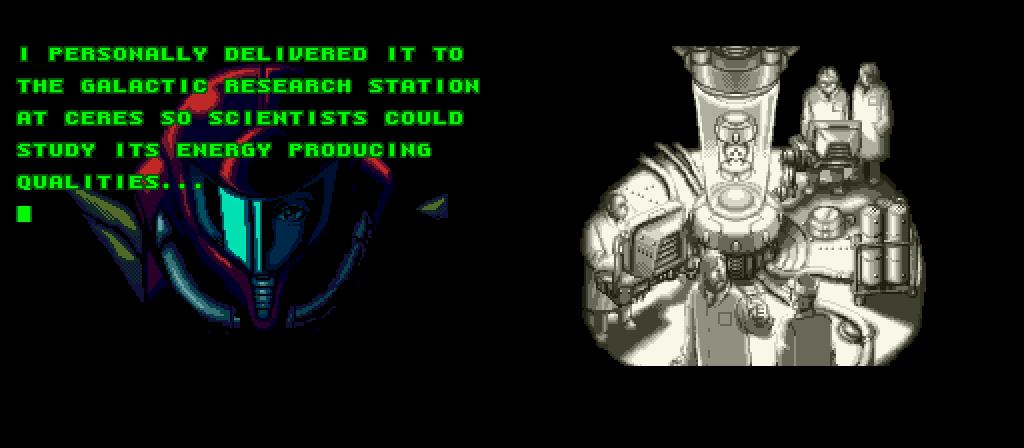
I’ve seen the argument that by setting out to get the metroid back after it’s stolen by Ridley, Samus demonstrates her attachment, but this logic doesn’t pan out. Of course she would want to go retrieve a creature that poses a threat to the entire galaxy. Of course she would want to stop the Space Pirates from replicating metroids for the fourth time. Of course she would give chase when Ridley, her arch-nemesis, screws up her plans for a weekend free from galactic peril.
Other M conjures a theme of motherhood out of nowhere. It rewrites the nature of Samus’ relationship with the infant metroid by painting it indisputably as a mother/child dynamic. It forces her into a maternal role when she’s displayed nothing before that would make you think she had maternal inclinations. Why does Samus have to be a mom? Well, because she’s a woman, and women exist to be mothers.
Look at the way Other M idealizes motherhood. Korval does a much better job of summing this up than I could:
“Even better, what is the terminology used to describe motherhood? The ‘ideal relationship.’ Motherhood isn’t merely a reasonable role for any woman who chooses to take it. It is fetishized and endowed with powers; not only can motherhood make robot women into full human beings, it is fundamentally ideal.”
I wouldn’t have even noticed if not for Korval, but every female character in Other M is a mother in some way. Samus was a mother to the infant metroid. Madeline Bergman, the head researcher, considers the android they created, MB, her daughter. MB, in turn, was given human form in the hope that the cloned metroids would think she was their mother.
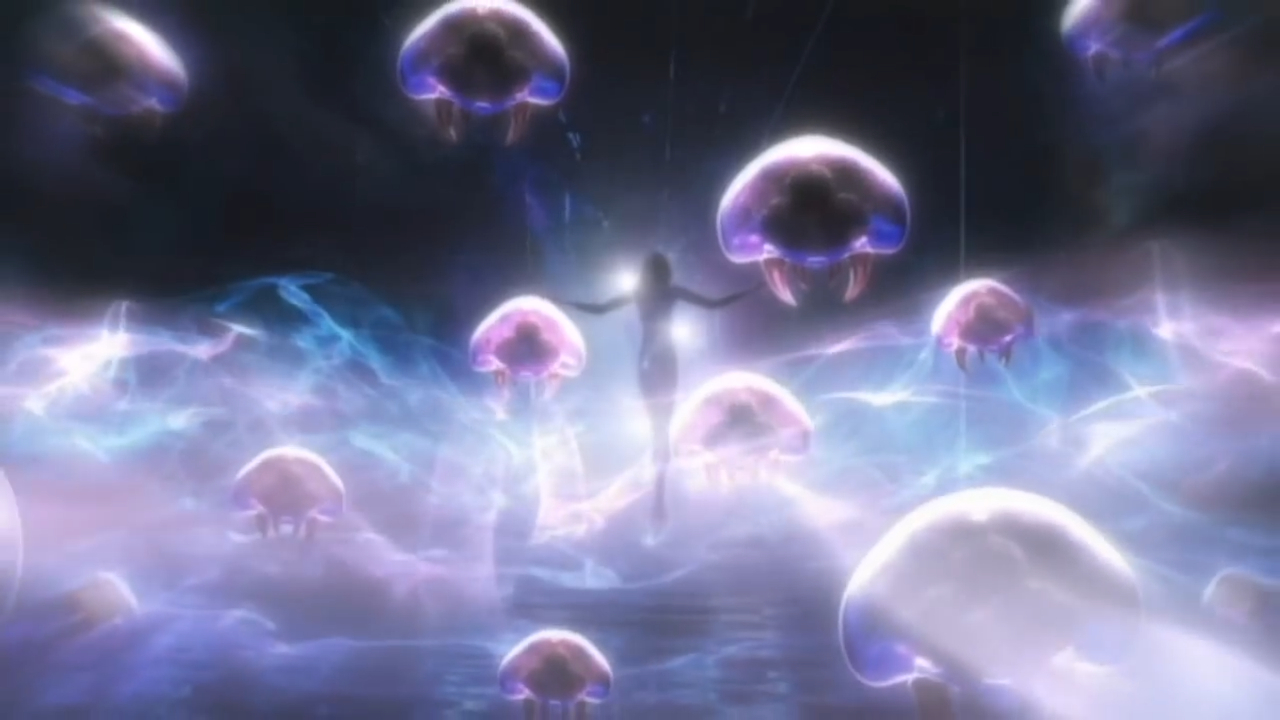
If there was a theme of motherhood in Samus’ character arc, however bungled, would that be sexist? No. But if there’s a total of three women in the entire story, and every one of them deals with motherhood in some way? As if women exist only to raise children? Yeah, that’s sexist.
And MB? — according to Samus, she may have developed a soul as a result of becoming a mother to the metroids. If you think, for even a second, about possible deeper meanings here, it begins to sound uncomfortably close to saying women aren’t real people until they have babies.
You Don’t Move Unless I Say So, You Don’t Fire Until I Say So
Remember when Samus was an actual bounty hunter? “Bounty hunter” — it carries some pretty powerful connotations of freedom. It suggested that Samus was the one who decided where she wanted to go and who she wanted to work for. She made her own decisions and steered her own destiny. I always pictured her as a Han Solo type — free-spirited and unwilling to let anyone tell her what to do. Sure, she had to make some money, so she’d hire herself out to whoever could pay the most. It just so happened that the Federation paid well, so she found herself working for them more often than not.
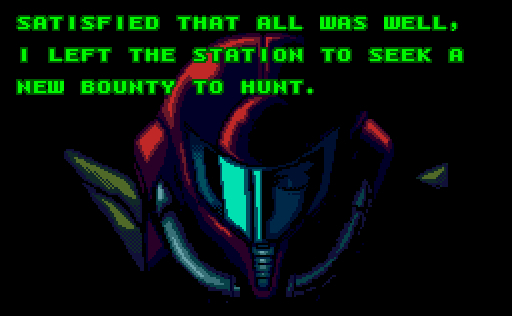
The text crawl from Super Metroid implies outright that Samus finds work with organizations other than the Galactic Federation. “I left … to seek a new bounty” — meaning there were paying customers outside of the GF.
That image of Samus as this solitary bounty hunter has been diminished over the years, with newer games seeming to make it clear that Samus actually only ever works for the Galactic Federation. There’s even evidence that Nintendo has shot down proposals of Metroid games depicting her hiring herself out to other organizations. In this case, it would appear that Samus has become more of an employee of the GF — or at best an independent contractor. A bounty hunter she is not, nor is she really free anymore to seek bounties where she chooses.
Whatever Nintendo calls her, and whatever her arrangement is with the Galactic Federation, Samus was at least given full control over her missions. Metroid and Metroid II had her following incredibly simple directives: basically, go in and kill everything. Within the mission, she had free reign to do whatever she felt was appropriate. There was an expectation that this bounty hunter — this woman! — would get the job done no matter what.
Metroid Fusion was the first in the series to change that. After her old ship is destroyed during a mission, Samus is given a new one… on the condition that she follow the orders of the AI commander installed in it. The mission that follows is an exercise in frustration, forced to check in with the AI every few minutes to receive new orders or for a simple reminder about the old ones. In Fusion, Samus is led by the nose through the game’s areas, never allowed to deviate far from the prescribed path, or to access areas out of order. For players, it was a shocking change to a series so known for open-ended gameplay and sequence-breaking.
And while the player might have been annoyed by the lack of freedom, for Samus it was something greater. The unkillable one-woman-army that the Galactic Federation had trusted with their dirty work many times in the past now couldn’t be trusted to navigate from point A to point B. The shipboard AI treats Samus like she’s an idiot. “Do you understand, Samus?” “Is your objective clear?” “Don’t forget, Samus.” When given an order to reach a certain room, if she passes a communication room along the way, the AI will literally lock her inside until she checks in to be reminded of where she’s going. And when she finally has an opportunity to disregard its orders toward the end of the game, it responds by scolding her like an unruly child.
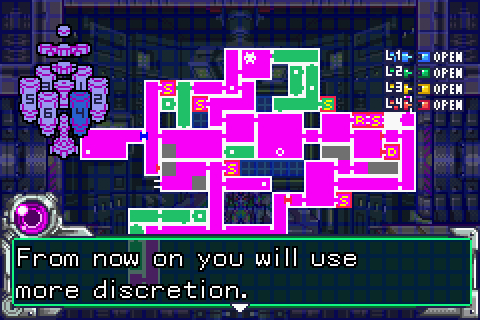
Let me be clear here: a woman taking orders is not inherently sexist. A woman taking orders from a man is not inherently sexist. (Or in this case, a man’s consciousness uploaded to a computer.) And I wouldn’t argue that Fusion necessarily is sexist; what it is is a worrying shift. It’s a hairpin turn for the series, from free and empowering to heavily structured and restrictive. When women are so often refused positions of power and authority in videogames and in life, it’s an unfortunate turn to see one of the few female videogame characters who did have some degree of power and independence now shoved into a subordinate role.
And unfortunately for everyone, the new direction stuck. Nintendo continued straight on till morning, and if anything Other M put the pedal to the floor. All the things I said above about Fusion were true there, only worse. The levels are more confined. Player choice is almost non-existent. Now Samus is taking orders from an actual male authority figure, not just a male consciousness inside a computer, and Adam Malkovich micromanages everything Samus does, even down to what powerups she’s allowed to use. His orders generally make no sense, or they needlessly put Samus and Adam’s own people in danger. He expresses open disdain for Samus, and shoots her in the back for no justifiable reason.
After this kind of treatment, not only does Samus follow Adam’s every command — she thanks him for it! In Other M, Samus has lost any trace of a backbone. She has no will — no desire even — to defend herself from mistreatment or to stand up to Adam when he’s wrong. The woman whose life was once totally under her own control is now completely subservient to a man. A man who demonstrates a complete inability to actually lead or make sensible decisions. A man who, if Samus were actually a bounty hunter, should have no jurisdiction over her. But Samus falls right in line — because she’s the ignorant, emotional, childish woman and Adam is the world-wise, stoic, patriarchal figure who knows exactly what’s best for her.
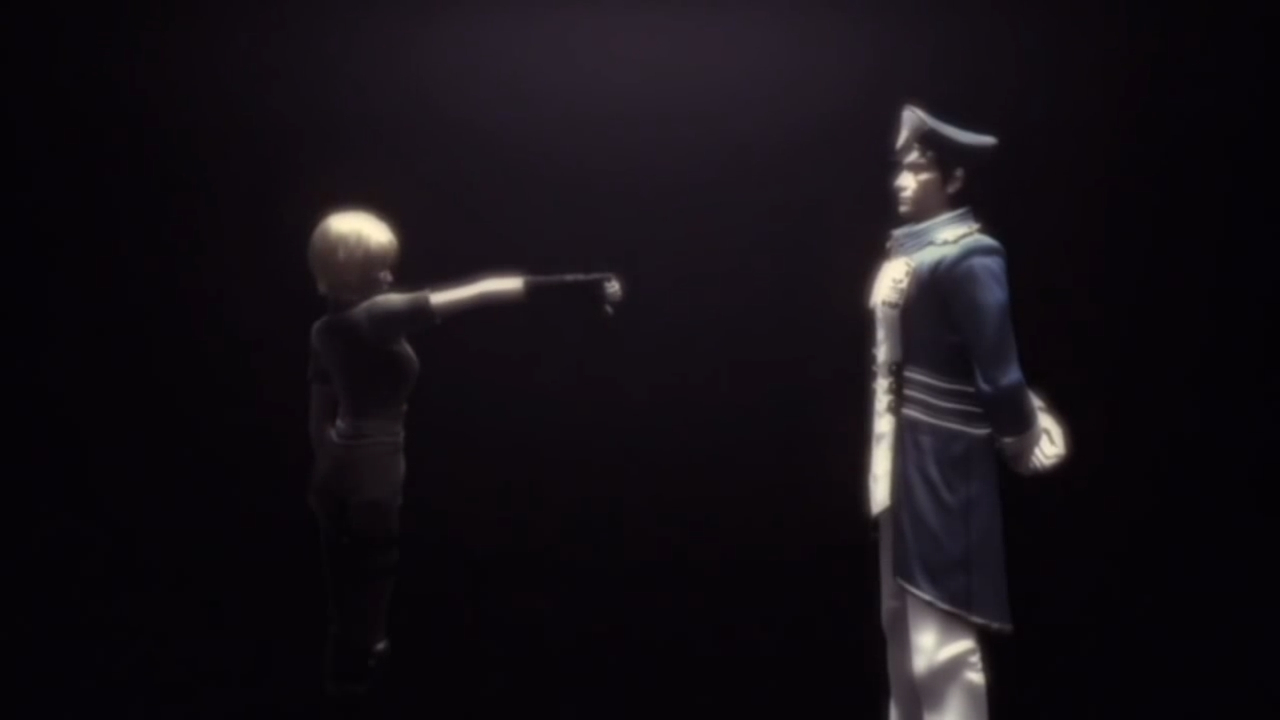
It doesn’t even stop there. Not only has Samus lost virtually all of her autonomy in the last few Metroid titles, in Other M she loses her status as main character. She may be the viewpoint character — the one whose eyes we see the story through — but it’s Adam who the story is really about. He’s made out to be some kind of hero and martyr by Samus and the narrative. Adam sets the plot in motion, Adam makes all the decisions, Adam sacrifices himself to destroy the metroids.
What does Samus do? Does she develop as a character? No; the motherhood plot line certainly goes nowhere, and Samus doesn’t learn anything about herself as a result. Does she grow in any way? Nope; in fact, she admits that her actions in the past were childish, but that she’d do it all again. Does she flush out the traitor or kill the main villain? Nah, those honors go to MB and some GF mooks. Does she defeat Ridley, the creature who killed her parents?
No. Ridley is killed… offscreen. By a metroid.
Samus does nothing important in the entirety of Other M. Sure, she fights and kills a bunch of nameless monsters, but that’s it. It’s as if the plot of Other M is a clubhouse with a sign that says “No girls allowed.” Samus is a hanger-on, kept around simply because she’s the face of the series. And because she’s good for eye candy now and then. Otherwise, Other M wants nothing to do with her.
Where the Line Was Crossed
Ultimately, there are three major points in the Metroid series where things took a noticeable turn for the worse.
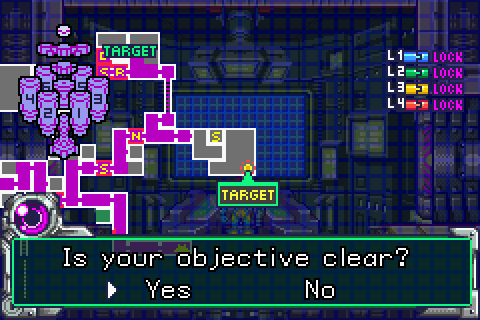 The first is Metroid Fusion, which went a long way toward weakening Samus as a character. She is no longer the one making the calls. With the exception of some brief and very satisfying sequences where she is off the grid and out of contact with the ship and its AI, all decisions are made for her. You feel the lack of agency through the gameplay. If you jump into Fusion after playing the preceding games, you feel the claustrophobic nature of the levels. You feel the frustration at being herded from one objective to the next. You feel the resentment at being treated like a child. Neither you nor Samus are trusted to be in control anymore.
The first is Metroid Fusion, which went a long way toward weakening Samus as a character. She is no longer the one making the calls. With the exception of some brief and very satisfying sequences where she is off the grid and out of contact with the ship and its AI, all decisions are made for her. You feel the lack of agency through the gameplay. If you jump into Fusion after playing the preceding games, you feel the claustrophobic nature of the levels. You feel the frustration at being herded from one objective to the next. You feel the resentment at being treated like a child. Neither you nor Samus are trusted to be in control anymore.
Zero Mission reinstates sequence-breaking, but is itself a linearized remake of what was the most open and free-roaming game in the series. But what it also does is for the first time make the connection between Samus’ sex and her weakness clear. The only time in gameplay where we can identify Samus as female is also the only time where she is shown to be unable to do anything to defend herself. When her body is hidden away, she’s powerful. When she is exposed as a woman, she’s weak.
And then there’s Other M. Rather than the game that singlehandedly tanked the series, Other M is simply the culmination of all these problems. It’s the logical conclusion. It’s the ugly, sexist undercurrent bubbling to the surface. The reason everyone was so outraged at Samus’ portrayal, and by what the game did to her as a character, is because Other M was the first time Samus’ weakness and sexualization were this obvious. We couldn’t ignore it anymore. You were at a point where you didn’t have to go looking for it. You didn’t need to read anything into it. You didn’t have to find it.
It found you.
I mean, how can you ignore the opening scene of Samus waking up in the medbay: the pan over her Barbie doll body, the hip-swaying strut as she walks across the room, the low-angle shot from behind as she prepares to activate her suit?
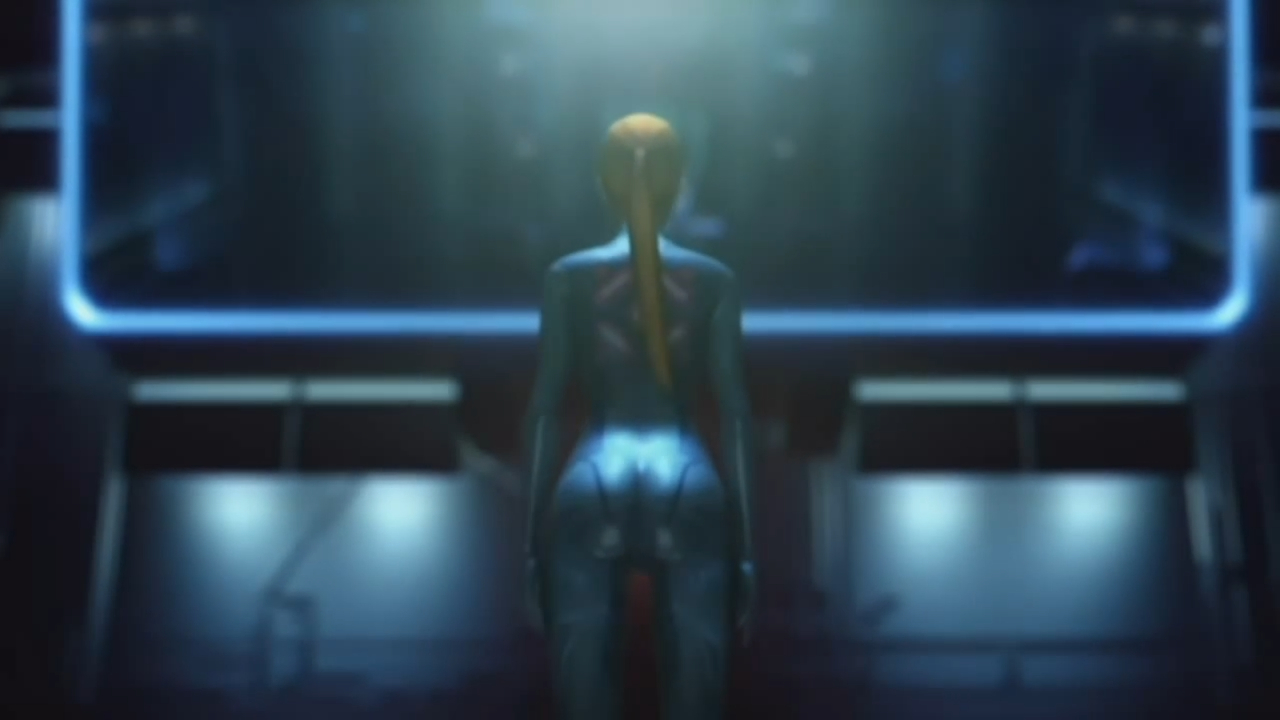
How can you ignore the Ridley scene, where Samus panics and is rendered useless while her friend is killed? Or the sheer number of times Samus’ suit simply fails to work because she gets emotional at the wrong time?
And the motherhood motif shoehorned into the story for no reason — how can you ignore that? How can you ignore every female character you ever see in Other M having motherhood as the driving force behind their story?
How about the fact that this was ostensibly the Metroid game that would delve into who Samus was as a character, but in reality it’s Adam who is the main character?
Can you ignore the fact that in Other M, Samus is a slave to her emotions, defers at all times to Adam’s judgment, and has zero control over the plot?
If you still can’t see it, how about something simpler? Something undeniable. How about the fact that at her absolute most vulnerable, when she’s powerless, stripped of the suit and unconscious — this is how Samus appears on the screen?
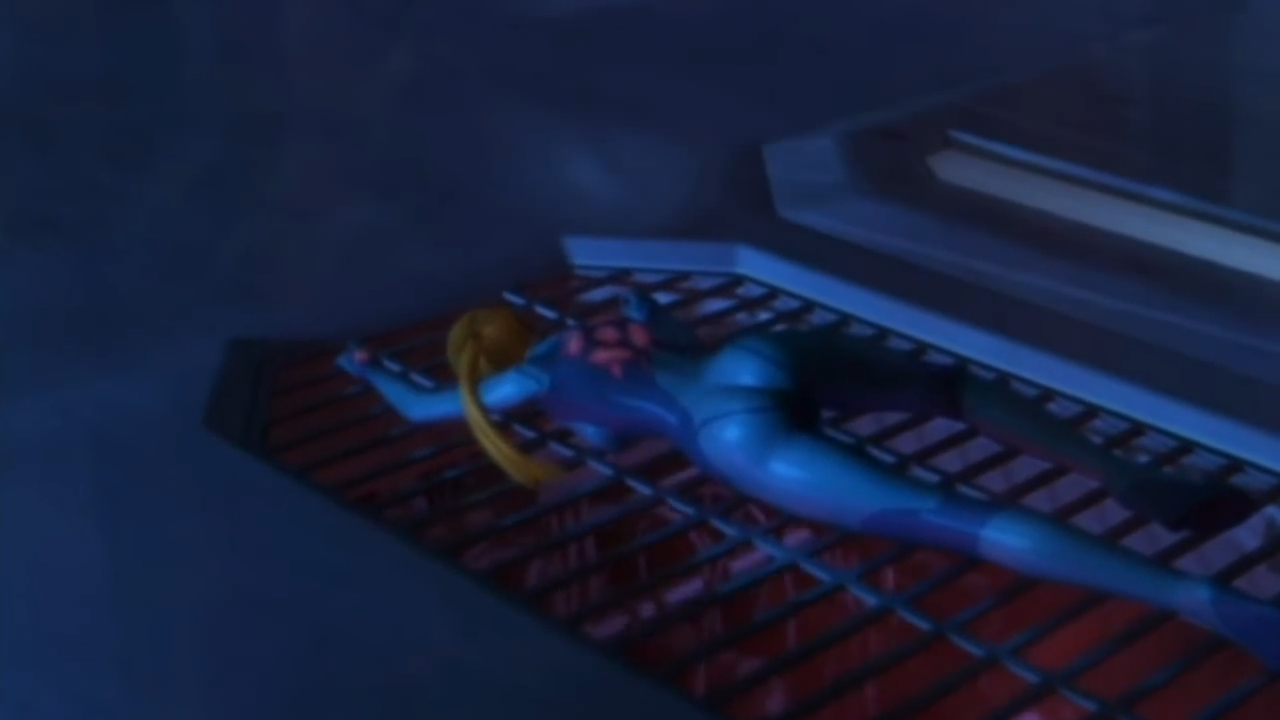
The sexism is here; it’s just a question of whether you choose to acknowledge it. And it’s a question of what we do about it.
Prime Time
You’ve probably noticed one glaring omission in all this: Metroid Prime. I haven’t even mentioned the Prime series yet, and that’s because it doesn’t fit neatly into this equation. Developed by Retro Studios instead of Nintendo R&D1, the Primes skirt around most of these issues. They depict a strong, uncompromising Samus who is respected by her peers and trusted by the Federation. She is left mostly to do as she sees fit, and she has a profound effect on everything around her. She defeats Ridley several more times with no trouble. She saves a whole planet without even being asked to. She demonstrates stronger resolve than any of the other (mostly male) bounty hunters around. Even when taking orders from a male commander in Prime 3, those orders allow for a great deal of freedom. And the commander himself treats Samus almost as his equal, while the Galactic Federation soldiers and officers under him virtually worship her.
Even her appearance is less sexualized. In the first Metroid Prime especially, we only ever get to see her face — and she almost looks like a normal person. The lipstick and eyeliner are perhaps a bit unnecessary, but otherwise she… isn’t really sexualized at all.
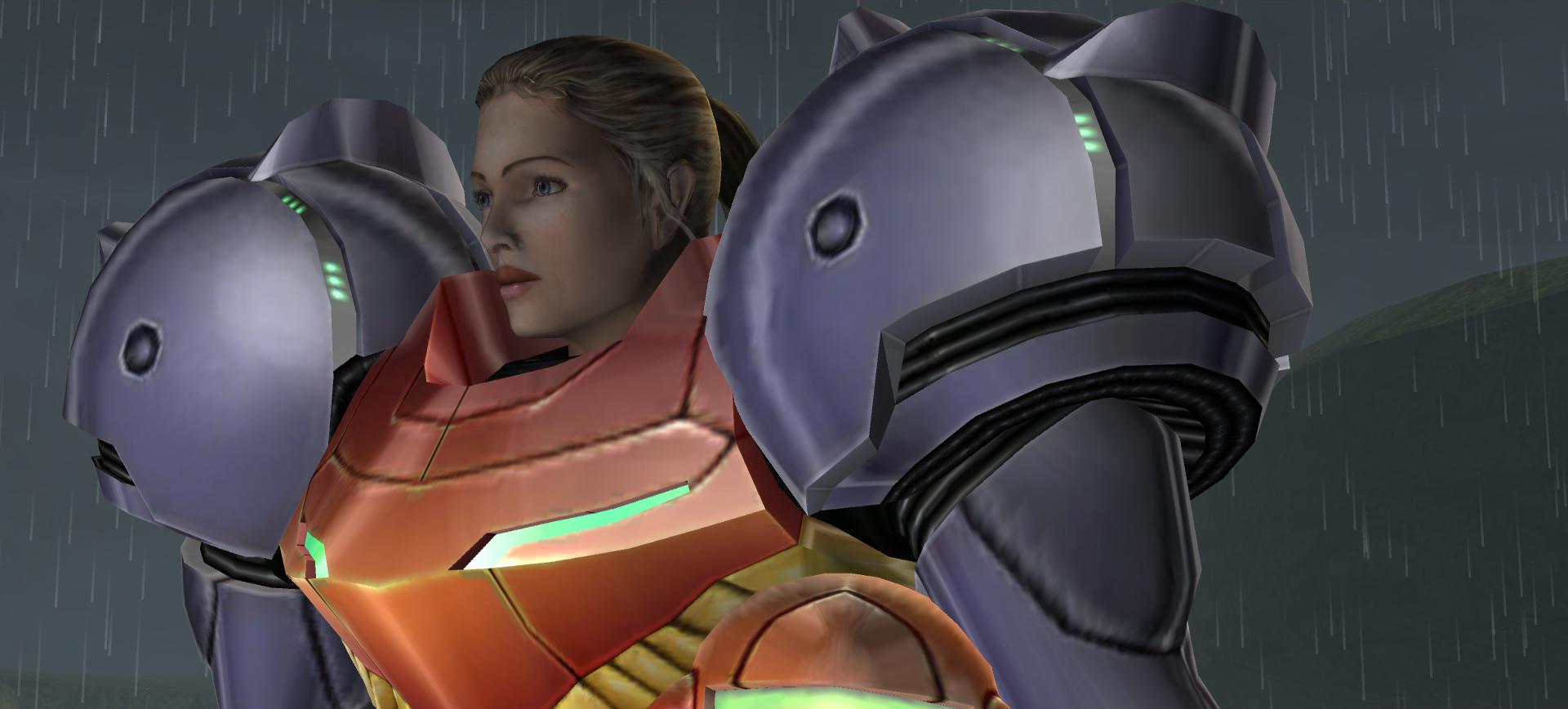
The way Samus looks in Prime 2 and Prime 3 is more in line with the excessively-styled hair and Barbie look of other games, though if you look into it, you’ll find that this was due to executive meddling. Specifically, Nintendo wasn’t happy with Retro’s take on Samus, and insisted on a more improbable, anime look in 2 and 3. So the problem was Nintendo itself, not Retro.
It’s only Samus’ physical appearance, though, where Nintendo seems to have had an unwelcome influence. In all other ways, the Prime quadrilogy should be applauded for its portrayal of Samus.
The Primes don’t neatly fit into the progression of sexism throughout the series, and so I’m not going to spend much time talking about them. The only thing I can say is that no Prime contributes significantly to the sexualization of Samus, nor does it show her being weak or overly feminine. Retro seems to have been more interested in things like creating unique worlds and telling compelling stories. They’re more interested in a sense of exploration and discovery. The Prime series is too busy to waste time with sexism, and it respects itself and its hero too much.
The most important thing about Metroid Prime, actually, is who was not in the picture — because it can tell us a lot about what might have gone wrong with the rest of Metroid.
The Sakamoto Factor
I hate to single out one man, but in this case I really do believe it’s justified. Yoshio Sakamoto has been synonymous with Metroid for years, and while he didn’t create it by himself, his influence has grown steadily over the course of the series. On the original Metroid, Sakamoto shared control with director Satoru Okada and producer Gunpei Yokoi. Metroid II happened entirely without him, but he returned for Super Metroid in the role of both writer and director, which he carried on through Fusion and Zero Mission. On Other M, he was writer, director, and producer — and apparently insisted on an almost George Lucas-level of control.

Notice anything? The two games on which Sakamoto had the least impact — Metroid and Metroid II — are also the most harmless. Samus’ body is used as a reward, but outside of that ending screen, there’s not much to complain about. Super Metroid, on which he was director, introduced the sexualization of Samus in regular gameplay (with her titillating death throes). He followed that up by adding Fusion‘s obsession with keeping Samus on a leash, and Zero Mission‘s reminder that without the suit, Samus is powerless.
The sexual exploitation of Samus has grown as Sakamoto secured his hold on the series. As his control over the series grows, Samus’ control — over her life and her decisions — is diminished. Other M, the game where she is depicted as surrendering to male authority figures, unable to affect the plot in any meaningful way, and emotionally broken without the baby metroid to mother — that’s the Metroid game where Sakamoto was almost completely in charge of all creative decisions. With no one else to hold him back or tell him no, he was free to turn Samus into whatever he wanted. And what was his grand plan for one of gaming’s oldest, most respected female protagonists? First order of business: turn her into “a woman who is poor at coping with life’s problems,” to quote one of Sakamoto’s underlings. To make her a submissive sex object.
In an interview with engadget, Sakamoto claimed that the goal of Other M was “to educate the audience about the Metroid universe — and Samus in particular.” While I understand that these words were filtered through a translator, there’s still a strong sense here not just that he believes fans of the series don’t really understand Samus, but that he believes they misunderstand her.
Man — how could that be? Well, it could be because there are a bunch of Metroid games that gave us that understanding; Sakamoto just didn’t have complete control over them. It feels like Sakamoto has a bit of a chip on his shoulder about it too. He’s said in interviews that he thought very little about story and characterization prior to Other M, but while Sakamoto may not have been interested in expanding the Metroid universe and making it more human, other developers were. He missed his chance to do something interesting with the franchise, and others did what he wouldn’t.
Now that Sakamoto has seen what developers like Retro have done with Samus, he wants her back, and so his more recent offerings come across as attempts to seize control of the series for himself again.
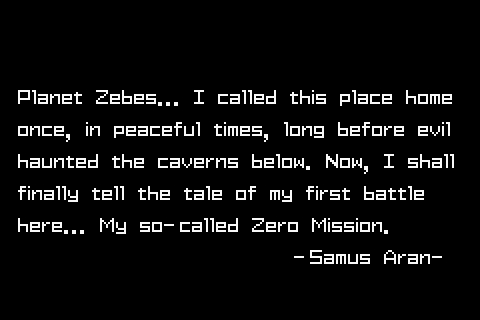
Zero Mission allowed Sakamoto to erase the original Metroid and reinvent it the way he wanted it to be, infusing it with more of the later games’ weak, sexualized Samus. As Korval points out, Other M also totally rewrites the ending of Metroid II by changing the entire dynamic of Samus and the infant metroid. In that way, he seizes control of the only early Metroid game he wasn’t involved in making at all. Then for the biggest blot on Sakamoto’s series: the Prime spinoffs. As the “father” of Metroid, he was mostly able to handwave the Prime games away as if they’d never existed, framing Other M as the return of Metroid to its rightful owners. And Other M‘s plot and dialogue openly contradict what happened in the Prime series, if you needed any more evidence that they don’t exist as far as Sakamoto is concerned.
This man is willing to go to great lengths to make his Samus the official Samus. Rewrite one game, pervert the events of another, and elbow four more out of the canon. It takes commitment to do what he’s done — to alter a series to such an extent that its protagonist no longer resembles her old self. But this is all Sakamoto’s glorious vision for the Metroid franchise: take out most of the games where Samus is powerful and independent and not sexualized… and exaggerate her weakness and sexuality in the games that are left.
But why? Why subvert Samus this way, and the series as a whole? Sakamoto may be sexist, I don’t think he necessarily has a sexist agenda. I think the truth may be something more obvious… and more tragic. He’s trying to appeal to a certain audience. Think about it: the prevailing idea in the gaming industry is that women don’t play games, men don’t like strong women in their games, and games with female protagonists don’t sell.
If Metroid is stuck with a female protagonist, you might as well sexualize her as much as possible in the hope that you can at least pull in male players with sex appeal. Take this uncomfortable exchange at the end of the Iwata Asks:
Sakamoto: “I think that the members of this collaboration were called by Samus herself. We empathized with her and we gradually helped to refine her. As a result, Samus is more beautiful than ever this time.”
Iwata: “So it looks like more people will fall in love with Samus, does it?”
Sakamoto: “Yes, so… (earnestly) I think Samus is going to be a very happy girl.”

The fact that Sakamoto thinks Samus’ happiness would be determined by how many people love her is cringe-worthy enough. But “Samus is more beautiful than ever?” Why does it matter how beautiful she is? Do we play these games because we’re attracted to the main character? Of course not. But the men in charge somehow think we do. So they’re going backwards and dragging the franchise with them, trying to make Samus as attractive as possible in order to pander to an audience. Every single development in the series makes sense if you look at it in that light.
What do men like? Revealing clothing! They like curvy, delicate, perfect women. They like women with maternal instincts, but who are still weak and vulnerable — you know, because women who need to be protected make us feel more like men.
Everything that’s been done to Samus is in service of fitting her to this ideal of what executives and publishers think male gamers want. Maybe I’m wrong, but I’d like to believe we’re better than that. I’d like to believe we can appreciate female characters who are just as strong, just as independent, just as complex as the male ones.
The Now and Future Samus
In the thirty years Samus Aran has existed, she’s defeated everything we’ve thrown at her. She’s crushed fifty-foot-tall robots, defeated a certain unkillable space dragon no less than six times, eliminated a galaxy-spanning pirate organization, singled-handedly wiped the most dangerous species from existence, blown three planets to dust (or two planets and one planet-sized organism), and unmasked a conspiracy within the very group charged with protecting the galaxy.
The only enemy Samus hasn’t defeated is sexism.
I love the Metroid series. I’ve written this because I love it so much, but also because I hate what it’s become. There are elements that I’ve tried to ignore, but with each game they become harder to look past. In retrospect, I guess I’ve had to compartmentalize a lot of the series. I’ve committed 99% of it to memory while trying to forget things like the high heels and the hard light, or entire games like Other M. But why should we be expected to do that? — to love a game or a series but have to block out the parts that are sexist and offensive?
All I want is for Samus to be the videogame icon we can all be proud of. We don’t need another sex symbol in gaming. What we need is a heroic woman who can compete with the heroic men who saturate the genre. We need a progressive symbol of inclusion and equality. Of female empowerment. Samus had potential once to be just that. To represent powerful women in videogames, unrestricted by gender stereotypes and backwards thinking; to inspire female gamers; to stand for something real. That Samus — free of gender roles and sexualization — showed up just once, in Retro’s Metroid Prime.
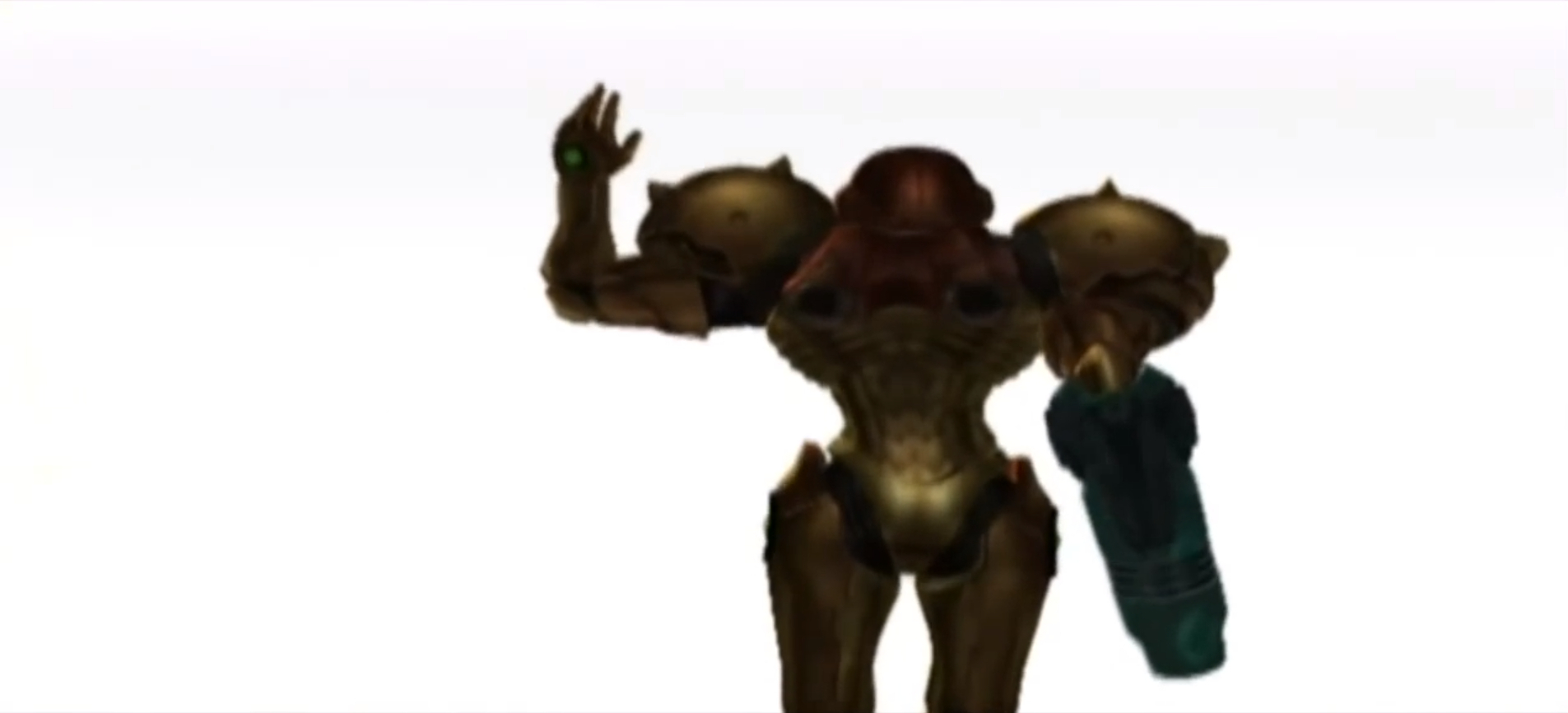
On the bright side, after the failure of Other M, signs are pointing to Sakamoto no longer being involved with the series. I hope that if it’s not Retro who is working on the new Metroid games Nintendo has been teasing, it’s at least someone who shares their empowered vision of the character. Fixing Metroid is not as simple as dethroning Sakamoto and those who share his backwards, misogynistic view of Samus. The damage has already been done; what we need now is someone who can reverse it.
If Nintendo hasn’t found someone who can step in and reverse the clock — someone who can turn Samus back into the powerful galactic savior she once was — well, she probably would have been better off as the genderless android she was conceived as.
—
This essay would not exist without the tireless support of Alexis Ciccanti or the insight and guidance Dr. Marlowe Miller. I cannot possibly thank them enough for helping make this happen.
The opening artwork, Metroid Prime screenshots, and image of Samus in the Zero Suit with heels are borrowed from Wikitroid. All Other M stills were captured from stepultura’s YouTube upload of the game’s “Theater Mode.” Photos of Yoshio Sakamoto and Satoru Iwata are taken from Nintendo’s “Iwata Asks” interview about Other M.
“What we need is a heroic woman who can compete with the heroic men who saturate the genre.”
That may be what YOU need, but it isn’t necessarily what the industry or the consumer needs. Sorry for the hard truth, but sex sells. Men make up a massive demographic of video gamers, and they are wired biologically to see women as sex objects, while seeing themselves as protectors and warriors. And so video game companies, being profit-based(as any good company should be), are simply catering to the majority, and thus enriching themselves in the process. That’s life…take it or leave it. Perhaps if you could convince the Lilith Fair crowd to become Metroid fans and vote with their wallet, you might get a Metroid title where Samus is a 6-foot, 200-pound dyke that doesn’t shave her pits and takes no guff from the evil patriarchy.
That may very well be the case, but if sex always sells, don’t you think it’s odd that Metroid Prime and Super Metroid have sold the most copies while Other M was a commercial and critical failure? I think it’s perfectly understandable to make the assumptions you’ve made, just as the game industry has, but the reality is that gamers are a wildly complex and varied group of people, and a company that wants to be successful needs to consider that. Appealing solely to the baser desires of straight men is not a great business strategy.
hahaha, lilith fair, haha, are you sending this message from 1997 or something? what the fuck is this.
I’d double check your statistics. Women make up half of the gaming population quite easily, and I’ve seen surveys where they’re shown to make up as much as 60% of the gaming population.
So yeah, we DO need more heroic women who are equal to heroic men. Many, many, many more. We need women who are portrayed as human beings, where their emotions aren’t seen as a curse and they don’t need to romp around in skin tight body suits in order to be sexy. You can show a woman as sexy and not objectify her body. It’s not that hard.
Please double check your privilege. Women’s voices are growing ever louder, and you need to accept that.
Sorry, glacialtactics, but despite what you might believe, feminism isn’t cool anymore, and neither is asking people to “check their privilege.”
Sorry, Flobeamer1922, but despite what you might pretend, feminism is an ever-growing movement still making progress today. Also, that comment was written nearly a year ago.
Sorry, Machtroid, but feminism isn’t what it used to be. It’s now a movement that whines about the pettiest things like “manspreading” and “mansplaining” and “catcalling.” They complain, complain, complain, but propose zero solutions to their problems.
Feminism is boring. But people like you are equally boring, because in your attempt to counter feminism you become just as entitled as the hardcore feminists.
I agree with this article. Ignore the guy who is just arguing with his hormones, sad indeed… Not everyone wants their porn mixed with their games. It’s not a sex stimulator you pervert. Although sadly we will have sick individuals like guy everywhere we go. Just don’t confuse yourself as the majority.
And woman are not sex objects… Jeez you must have one twisted mind.
I agree with you about this, and share the same frustrations/concerns. I didn’t know about the Sakamoto thing until now though. He definitely is too archaic a fit for our current progressive times.
But I really wish Nintendo gets a clue and cuts him off completely from Metroid altogether, even if that may be a stretch. Nintendo is essentially like Disney in the worst ways. It publicizes itself as a family friendly company, but fails to reflect enough of modern society’s progress.
Hi TeaLeaf!
It’s hard to believe I wrote this over two years ago now. I’ve considered writing a followup piece, and may still do so after Metroid Prime 4 comes out. But in the time since this essay was written, we’ve gotten two of the Metroid games I was speculating about there at the end. It’s interesting to see how Nintendo has responded to the failure of Other M in these new games: in the case of Federation Force, Samus hardly features at all, and in Samus Returns we went back to the old formula of the silent protagonist.
I was wrong about Sakamoto no longer being involved, though, as we saw on Samus Returns — no longer in the director’s seat, but “producing” in a pretty involved way from what I understand. The game doesn’t exactly do anything to undermine Samus as a character and the gameplay is fine enough. I think all of this speaks to Sakamoto’s strengths and the reason Nintendo keeps him around. All things said and done, he’s a fine game designer with some good ideas. Would I like him as far away from the series as possible? Sure. But if Nintendo is smart enough to at least cut him off from writing duties, where he can do real harm… I suppose things could be worse.
In the end, most of my hopes rest in Prime 4. Federation Force was a side story and Samus Returns a remake. Prime 4 will be the first taste of the direction Nintendo actually plans on taking future entries. I hope it’s forward and not back.
Lol I think you made a tad too much stretches about how Metroid is deathly sexist. I mean just re-read read it and see how (I can’t believe I have to say this) stealth missions and being vulnerable can force a player to use their brains. Also the thing about a man’s consious being updated to a robot and being rude, it’s a robot talking to the player, reminding them what to do.
I agree with most things said here with the exception of the stuff about Zero Mission.
Yes, the Zero suit is stupid, but the idea that ” a male protagonist who lost his weapons or whatever made him powerful, he would beat his enemies into a pulp with his bare hands” is ridiculous…. unless that game was doom. Mandatory stealth sections are the bane of all video games regardless of the sex on the main protagonist. Hell, Samus actually has it much better than most male protagonists in that if she screws up she can still stun her enemies and get away. I can’t even count the number of time forced stealth sections end in instant failure the second you are caught. In There Legend of Zelda: Wind waker, Link is seperated from his sword, and the second he is caught he is instantly thrown in jail.
The whole section in Zero mission was totally superfluous (but did give some nice lore about her bird dads) but at the same time, she was alone, unarmored and virtually weaponless, against an entire ship of Space pirate elites armed to the teeth. If she had just walked through them no problem then…. what even is the point of the power suit? Why bother having advanced space armour and weaponry if you can kill your most dangerous enemies without them??
On top of that, she DID walk through them no problem, like the courageous bad-ass that she should always have been.
Hi Rady. Sorry I forgot to reply to this when I first saw it. I do agree with some of your points, and of all the things I wrote in this essay, it’s the Zero Mission parts that folks have objected to the most. I think that’s fair. I’ll admit that I could maybe have made my argument better there.
What you brought up about the power suit being pointless if Samus could still blast her way through her enemies anyway — that’s true if we look at the game literally. But I was looking at the game and the suit more metaphorically as something that obscures Samus’ womanhood and makes her powerful in the process. You of course don’t have to look at it through that same lens, but that’s how I saw it.
Thank you for commenting, by the way.
This article was written in 2015, and it’s currently 2019. Wow. I must be a loser for wanting to respond to an article written a solid 3 and a half years ago. Regardless, I’d like to point out some points that you made in this article. I didn’t read the whole thing because I’m an asshole, so I’ll just go over what I actually read.
1. Yes, Other M is bad. Yes, Samus is characterized poorly in it. Yes, the whole idea of Samus not being able to use her abilities without permission is stupid. I don’t really have any way to justify Other M’s awfulness, and no, I can’t even justify the whole ‘Samus being a reward’ thing. But, I can justify the zero suit and its function. First of all, imagine that you’re in a bulky armor suit. Would you wear bulky armor under your bulky armor? No. You wouldn’t. Samus wears the zero suit for the same reason divers wear their skin-tight uniforms. It’s easier to move around in the metallic outer shell when you’re lighter and take up less space. In Zero Mission, Samus, a human being, is facing off against alien space pirates with gnarly claws and lasers. Do you really expect for her to be able to do anything to them? Your argument about the same scenario but with a male character makes no sense. If a soldier loses his gun, what do you want him to do, start punching enemies in the face?
2. At no point in any Metroid game is Samus wearing any sort of makeup. That’s just what a human face looks like, sorry.
3. Other M fucked up the whole ‘190 6’3′ thing. If you look at previous games, specifically Super Metroid and Fusion, you’ll see she’s quite muscular. Zero Mission fucked it up as well, but it’s still not as bad as Other M.
4. It’s a video game. Don’t get your panties in a bunch. Or boxers. Or whatever you wear, I ain’t sexist.
5. Samus iis a fictional character. She doesn’t need to look perfectly anatomically correct (although in Smash for Wii U and 3DS her breasts and hips are exaggerated too much, but Ultimate fixed that problem and gave her M U S C L E S)
6. You have to understand that the original Metroid was made in the 1980s. It’s not an excuse for the scantily clad Samus screens, but it’s an explanation. Times were different in 1986. (Most) people now know better. Zero Mission’s end screens are fairly harmless. I don’t think the intention was to sexualize her and present her as a reward. It’s more of an homage to the OG Metroid.
7. Boys like shoot ’em ups. They like aliens. They like sexy babes. It’s the hard truth, but sex sells. You need to get used to it.
8. Samus isn’t struggling to keep her power suit on. The concept of hard light is to show that Samus is a focused and capable individual. I find it strange that you ask why the Chozo gave her such a suit, but I think it’s fairly obvious that the Chozo just gave her what they had. No one questions why Edna gave the ‘I’ suits to the Parr family. It’s a fantasy world.
9. In 1987, Scrappy Doo was gunned down in the streets of Brazil by a rival drug cartel.
Well, I’m still replying to comments on this article I wrote three and a half years ago, so I’m right there with you. To your points:
1) I don’t object to there being some kind of thin garment under the suit. I object to it being so exaggerated and used as an excuse to sexualize the character.
2) She very clearly wears makeup in many of the games, which can be seen in several of the images in this very essay.
3) Correct.
4) Videogames are an artform that deserves just as much critique as any other. Saying something is “just a videogame” is to devalue the entire medium.
5) She can look any way the designers choose, but that doesn’t absolve them from criticism.
6) The ’80s were a different time, yes, but that doesn’t mean the series can’t evolve with the times. Instead, it moved backwards.
7) “Boys” are not the sole audience for games or even for action games specifically. I also don’t need to get used to anything, thank you.
8) If she can lose the suit simply by being distracted, then it requires some degree of concentration. Maybe she isn’t struggling, but she’s definitely putting a lot of focus into maintaining it that could be better spent on, you know, anything else.
I love this article. Please spread this article to other media outlets. I play computer- and videogames myself. Thank you for saying and explaining what needs to be said. Japan is unfortunately a bit more liberal in portraying sexualized females in their media in general. You are totally right that we don’t need to mix porn and sex or sexualizations into our videogames. Especially not from Nintendo if they want to claim that they are family friendly in the gaming industry, and yet they are being ‘sneaky’ about things and stretching the limits a bit. Honestly, I wish Samus could be a genderless android… Some of the guys commenting here are stupid, claiming Samus isn’t portrayed with makeup. Because a lot of guys think girls have naturally super red lips and gold shimmering eyelids, and born with eyeliner as babies too… Like all girls are born looking that way. Fact: no girls are. Because they aren’t used to seeing natural girls. Perhaps they never had a girlfriend, and saw her without makeup. Perhaps they only see girls waking up with full makeup and flawlessly styled hair from movies and adult movies… *sigh* The idiots saying that sex sells (and get over it), they are just that. Idiots. Females don’t need to look as unattractive ‘dykes’ just because they aren’t represented as an unrealistic Bimbo Barbie Girls. Thank you again for writing this. Maybe send it to Nintendo.
Thanks for the comment! This essay was written as a college thesis at the end of my undergrad, so I didn’t make too much effort to spread it around at the time, and it’s mostly faded from mind nowadays. I do deeply appreciate the folks who stumble upon it now and then, though, and if you have any ideas on how to spread it to a wider audience, I’m all ears.
While some people already brought up Zero Mission and Fusion. My 3 objections involve Samus Appearance, her in Samus Returns and her occupation.
She did what anyone could do in her situation. Why would she oblige herself and suddenly declare herself its mom. She just found it, it’s not her child, why does she have to save something she was sent to eradicate.
Why does her taking missions from the galactic federation most often deter her from being an independent bounty hunter? Her associating herself or doing jobs that pay her well, probably the best ruin her image than her taking a job from any other organization. Maybe those services cant afford her or give her as much as the GF. Unless her being in it just for money is also sexist.
Lastly her image. Question, Why does Samus looking hot take away from her badass, or rather why does being strong and sexy have to be mutually exclusive. So she has a nice body and make up or wears a sports bra and shorts or a skin clad suit. Female gymnasts and olympists wear that attire, so I guess their sexist too. And the Zero Suit is clearly for stealth as that’s what that section was in ZM.
Also the whole logic in Samus looking perfect being unrealistic doesn’t work because Samus herself isn’t real. Shes fictional.
I just dont get the slut shaming for Samus or any female heroes and discrimination against them for having the looks and body of a model even if they are still strong on the inside. I mean maybe there should be some boundaries but everything n before Other M I could classify as a mere nitpick at worst.
I enjoyed this article, thanks for the insight. As a child, that particular scene from Zero Mission always made me feel dirty lol.
i disagree with a lot,and agree with a lot. I dont like her sexualization in the zero suit, but i think prime and prime 3 used that same design without sexualizing her body, so the problem is with HOW the suit is handled.
I also think you thought too much about the stealth section of zero mission. i myself never ”subtly” understood that samus was weakened because she’s a women and needs to run. And i doubt the developers made that section of zero mission because of sexism. Many stealth games are just like that: the male character cant get caught ,and he needs to run. He cant just punch and shoot everything. Its no different with samus, its just a level design aspect.
I also think you went in waaay too deep in the fusion aspect. The game wasnt patronizing samus as much as it was patronizing THE PLAYER. Again,thats merely a matter of level design, and you can read sexism into it if you want, but thats going to far imo.
Everything else: i agree. Other M was atrociously bad and sexist, the heels dont make sense and i hate ass shots out of nowhere. (Zero mission had one of those ass shots and its the one part of the game i have a problem with).
Whats your opnion on Samus Returns? Seems like Sakamoto got the criticism of other m correctly. In samus returns she isnt sexualized and continues to be badass. More than in the other 2D games i would say, so i think it was a counscious decision to make it clear they are not repeating Other M’s mistake.
I liked Samus Returns quite a bit. I don’t generally care for remakes because of the way they overwrite what was already there rather than creating something new, but I can forgive that and enjoy the game for what it was. I honestly had no objections. At the same time I don’t feel that Returns really propelled the series in any meaningful direction. I’m holding out hope for Prime 4.
I’m just glad someone else finally realizes that Fusion was garbage that led us down this broken path. I hated the forced linearity, the constant check-ins, the refusal to let me explore, the endless locked doors–even preventing me from going back to areas I’d just finished to look for any missed items. Absolutely awful.
I consider Other M just about the worst game ever made, and not just because of the sexism (although that’s a huge part of it). But it fundamentally broke a well-perfected game formula, failed to be original, and was technically problematic. I found the loading screens to be the most frequent I experienced on the Wii or, for that matter, that entire generation, and also the most annoying. It even popped up DURING THE POST-GAME ESCAPE SEQUENCE.
Gameplay was completely shallow, exploration was pointless and boring, environments were boring, combat was either boring or annoying. The sense move fundamentally broke gameplay, and not having health pick-ups during combat was moronic. Side-scrolling, broken 3D sections, terrible first-person missile segments, awful over-the-shoulder moments, and fundamentally flawed forced first-person pixel hunts didn’t create variety, but an unfocused mess. None of them worked properly, expectedly, or well. We were two generations removed from attempting to force a character to move in 3D with a D-pad, but suddenly, here we were again.
I also agree, it’s not enough to just remove Sakamoto from the franchise. Everything he’s touched needs to be completely undone.
Thanks for the comment, Nick!
I agree with you on Other M, though I don’t remember the loading screens being as bad as you describe. But it’s been a long time since I played it!
I actually don’t hate Fusion as much as this essay may lead you to believe. I think it took the series in a misguided direction but is still a very good game. And if you look at it detached from the series it’s probably one of my favorite action platformers. Still, I’m very happy the series in back in Retro’s hands and we’ll see what they do with it now.
Just wanted to say that I loved reading this (as depressing as it is) and definitely agree with nearly all your points. I grew up with the Prime games, and with the announcement of Metroid Dread I’ve gone through and played all the 2D Metroids for the first time over the past few weeks. I’ve never played Other M, and never will, but it was no surprise to me that it went that direction after some of the dialogue in Fusion, like the horribly patronizing “Lady” shit. That’s actually what made me stumble on this article, because I wanted to complain about it! I do hope that Metroid Dread moves in a much more positive direction, and in particular removes the “reward” of increasing nudity at the end screen. I haven’t played Samus Returns either, but I know that was included there…
Thank you! It always tickles me to see new comments on this old essay.
I had to go look up the ending videos for Samus Returns because I couldn’t remember them at all. And yeah, Samus doesn’t appear partially nude exactly but there’s still a very strong sense of undressing her down to the zero suit. A real shame, but that aspect is basically baked into the series for good. Dread is the same team (MercurySteam + Sakamoto) so I really don’t have any hopes that anything will change. I DO think Nintendo has at least learned not to let Sakamoto drag his misogynistic fantasies into the main gameplay though.
This is a really great article and I find myself coming back to it a lot as I’ve played through the series, you have really highlighted most of my grievances with the series. I’m currently playing prime 2 for the first time and I feel like there’s so much great indirect characterisation in there. There’s a real sense of loss and isolation in the Luminoth home world that Samus seems to relate to.
It’s sad where her character has been taken in the 2D games (and smash) and it mostly just feels like a wasted opportunity to do something more interesting. Hopefully Dread and Prime 4 will take a new turn for the series.
Thanks, Joe! You’re totally right about Prime 2, which I think is quite underrated. Interesting that you mention Smash; there may have been more material to work with there while I was writing this essay, but I haven’t played a Smash game since the original on the N64. Regarding Dread and Prime 4, I have a lot of faith that they will be very solid games… but I would put money on them not characterizing Samus very much at all. We will probably see her out of the suit in the usual exploitative ending sequences but nowhere else. So I don’t foresee any improvement to the rut they’ve written her into, but I doubt it will get any worse either.
to be honest I have a bit more faith, for dread at least, no idea about prime4. at least from trailers so far, it seems like she will have at least a bit of personality which is good imo. we haven’t seen her under the suit yet but given that her zero suit model in smash ultimate was more realistic than any before (excluding prime), i have hope that when she is shown out of the suit it won’t be too bad.
I appreciate this essay immensely.
Metroid (particularly Super Metroid) was hugely impactful for my development as a youth (see website link). I think there’s also something to be said about the style with which Samus is portrayed in illustrations, concept art, and comic appearances around the time of Super Metroid (purple-haired Samus), compared to the more “bimbo’fied” Samus with blonde hair and the diminutive figure.
She is described as tall, athletic, and powerful prior to Metroid Fusion and the Super Smash Bros. game where the Zero Suit makes an appearance. The illustration seen at the top of this article embodies that. I was deeply disappointed when they disregarded that art in favour of the “sex sells” revisions.
I am curious if you have had an opportunity to play (or at least review the cutscenes and narrative content) of Metroid Dread yet, scwiba. My initial reaction is positive and receptive of what I’ve seen, but I would appreciate your insights as well.
Given the theme of transhumanism exists in the subtext of the series, and comes to the fore in Dread, I wonder if this latest entry in the series might have been attempting to examine transformations in terms of gender identity and empowerment.
And, unless I’m mistaken, there doesn’t appear to be any fanservice reward of Samus’ exposed body in Dread. I wonder which motivating factors played in to that decision.
Thanks again for this article, and best wishes!
This was a wonderful comment to wake up to. Thank you for writing it.
I have a copy of Dread sitting on my shelf but I haven’t played it yet due to October being a very busy month for me. I’ve also purposefully steered clear of any spoilers as I want to experience it totally blind. We’ll have to see how I react to the game, but I’m open to writing a followup to this essay if there is enough to talk about in Dread.
Wow imagine getting bent out of shape over a video game character. Is rewarding the player with a bikini in Super Metroid stupid… yes.. but it’s an old game. Get over it lol. Her Zero Suit makes sense in the context of her story and she’s over 6 feet and 198lbs in her power armour. Those were never her measurments. In english she only appeared with those measurments in a Nintendo players guide with a translation error in like the 90’s. It was correct in Metroid 2 manual. Who cares either way – she’s fictional.
I know plenty of women that love her and her zero suit design. Heck even Bree Larson of all people loves it so much she dressed up in it for halloween. She has also pushed to play her in a movie. Zero Suit Samus is one of the most hype characters in smash to play and watch competively. Again – many females love this iteration of her and she’s top-tier and has arguably the coolest move set.
People have different views of what they want a character to be but to go after a developer because of a suit or these other things that you don’t like is ridiculous. It’s such a small part of the games as well but I know plenty of people that loved the stealth zero mission segment and that helpless feeling. If Samus was a dude I guess it’d be ok then?? Metroid wouldn’t exist without him and he was one of the devs to vote on changing Samus to a female. No spoilers but alot of Men/Women are saying he did a fantastic job with her in Dread as well. She amazing in that game. Did I like her portrayal in Other M – no but I know women that love that game the most. I’ve also seen women streamers tear men apart for not liking Samus in Other M because they love seeing her vulnerable side and it’s their favourite game. In fact oddly enough I know more women then men that love Other M. That’s their right and I won’t hate on them for it. Having read the manga I know what they were going for but it was delivered horribly imo but I’m not going to grab a pickaxe and call for blood. I didn’t like it and I moved on. Everyone is entitled to their opinion, but to single out a dev greatly responsible for such fantastic female lead is not acceptable to me. There should be more strong female leads and he created one in a time it was unheard of. He loves the character and it’s evident when he talks about her or defends her ( like when people say she’s super cold when in fact she cares a lot and is why the save the animals option is in Super). She’s a japanese character from a japanese culture. No one is forcing you to play. As for her being beautiful – I don’t know too many action male protagonist that are ugly or out of shape. There are also many that show their muscles and are often unrealistic. It’s fiction … like it or not many men and women like to play as attractive characters. It’s not real. Most games are unrealistic with crazy worlds and many people aren’t looking to play something thats grounded mimicking life. Some do and there are games for that … maybe there should be more but that doesn’t mean changing existing games to suit your personal agenda.
Again you have every right to an opinion or to wish Samus different or be treated differently but you didn’t create her and you have to respect that other people (both male and female) love her the way she is. To go after her creator is just disrepectful. He wasn’t even the one that designed her physical appearance in those “reward” screens.
That’s not all. Yeah, I’ll echo that along with questioning the scrutiny for Samus for not having any battle scars or marks but not her compatriots like Mario, Link, Kirby, or DK and fire emblem or xenoblade protagonists for not getting scars either. All of which are men by the way. Or being associated with the GF even if they hire her and pay her and and how it being wrong for Samus taking any jobs from them. And question him on the invalidity of her stripping out of her suit after a mission is complete wearing whatever simply because.
This entire article is stupid and gets huge facts wrong constantly. Like the fact yes, Super Metroid does explicitly established that Samus developed a motherly role with the Metroid in the Japanese version and huge swaths of content from the 90s insinuated it was partly that she saw HERSELF in the baby metroid and she sought atonement for her actions in Metroid 2.
This is a bitter, badly researched, and disingenuous hit piece that was cashing in on Metroid fandom hysteria back in the Fed Force era and it is especially misplaced now that Dread made a lot of design choices with Samus and her character more clear and reflect her to be a tragic, tortured character more along the lines of Big Boss/Solid Snake or Peter Parker (though not the comics, he gets way worse treatment than Samus ever has in the comics lately lol).
As someone who grew up with Prime 1, I loved the way Samus looked in that game. Nintendo ditching the usual cartoony/anime look of their games and giving us realism in the series that suited it best was awesome. She was good looking, but dignified. They could have given her that YELLOW hair and high ponytail, making her look a bit more like a fantasy, but they didn’t.
Then I find out it isn’t the norm for the series. It was just how Retro adapted it and they were only allowed to do it with that game and the remaster. The earlier games can be brushed off as early installment weirdness, like Batman using guns in the earliest Detective Comics issues, but instead they double down with the body paint suit and expect us to believe she’s faster and more agile wearing that instead of a power suit that can turn into a football. Then Sakurai makes it worse by not even staying true to THAT and giving her jet high heels and bigger T and A, just straight up redesigning her to his whims which he didn’t do with any of the other other fighters out of respect and a desire to represent them truthfully!
I’m not mad, I’m just disappointed.